








In order to understand why Finland would ally itself with Nazi German one has to go back to 30 November 1939. The day the Soviet Union illegally attacked Finland in an effort to grab territory from their northern neighboring. Finland was no threat to the Soviets. This was a pure, unmitigated act of aggression on the part of the Soviet Union. The attack was deemed illegal by the League of Nations, which resulted in their expulsion from the League.
Finland, a small peaceful nation, was heavily outnumbered and out gunned by the lumbering Red Army in tanks and guns as well as personnel. To the Russian military staff, this seemed like an easy conquest of land and resources. Unfortunately for the Soviets, the Finns had other ideas. They put up a gritty and determined resistance and held the Red Army for a solid three and a half months inflicting heavy losses on the invader. Very little headway was made by the Soviet Union into the territory they expected to simply walk into.
After the Red Army reorganized and changed its tactics, the Finnish defenses were overrun and Finland was forced to sue for peace. In the Moscow Peace Treaty, Finland was forced to cede eleven percent of its territory to the Soviet Union,

representing about 30 percent of its economy.
Finland’s defiant stand, early successes and effective defense against a much superior aggressor increased their standing in the eyes of the global community. Especially since they were the underdog and innocent party in the conflict.
At the beginning of the 19th Century, Finland was part of the Kingdom of Sweden. Saint Petersburg (later changed to Leningrad), at that time, was the capital of Tsarist Russia. The thinking at the time was to create a buffer territory around the capital that lay too close to foreign territory and Finland was invaded and conquered by the Russians. The seeds of hatred between these two countries were now planted and would not resolve themselves for more than a century.
The First World War led to the collapse of Tsarist Russia and the new Bolshevik Government precariously weighed its options while consolidating its position. The Russian Revolution and Civil War gave Finland a window of opportunity to retake its independence from Soviet Russia and make its move. The Senate of Finland declared its independence and after a brief Civil War, expelled all
the Bolshevik forces from Finnish territory. By May of 1918, Finland achieved full autonomy and recognition from the Soviet Government.
During the ensuing years, Finland made unsuccessful military excursions into the Karelian in order to unify all Finnic peoples into a single state. In 1920, an assassination attempt was made on the Finnish Commander in Chief, Carl Mannerheim. By the end of 1920, the Finns and Soviets finally came to an agreement on a proper Finnish-Soviet border that was based on the same border that existed between the Grand Duchy of Finland and Imperial Russia. As far as Josef Stalin was concerned, this was a disappointing arrangement.
In 1938, the Soviet Union approached Finland with diplomatic efforts to get Finland to cede or lease lands along the Gulf of Finland to the Soviet Union as a buffer against a possible war with Nazi Germany. Finland refused, while maintaining its neutrality should any such conflict arise. In August of 1939, Nazi Germany and the Soviet Union signed the Molotov–Ribbentrop Non-Aggression Pact that divided Europe into spheres of interest. Unfortunately for Finland, they fell into the Soviet sphere of influence. As too did Latvia, Lithuania and Estonia.
Finland began to mobilize. The Soviets had already started an intensive mobilization in the vicinity of the Finnish border. The Soviets wasted no time in inviting a delegation from Finland to Moscow to demand the cession of Finnish territory near Leningrad to be pushed back to 30 km east of city of Vipuri and for all defenses in the Karelian Isthmus as well as leasing the port city of Hango to the Soviet Union for a period of 30 years so they could establish a military base on Finnish territory.
Finland responded with a more conservative counter offer. As fate would have it, a mysterious shelling incident occurred at a Soviet border outpost on the border with Finland whereby four Soviet border guards were killed and some others wounded. Of course, later investigation determined that there were no Finnish artillery units anywhere near this area and the operation was conducted by the NKVD in order to give Stalin a reason to withdraw from the non-aggression pact with Finland.

The usual Molotov bluster of demands, accusations and threats followed. Finland denied culpability and refused to meet any of the Soviets ridiculous demands. At which point, by the end of November, the Soviet Union declared Finland hostile and withdrew all diplomatic efforts.
To this day, Vladimir Putin (the democratically elected President for life and possible permanent leader of the former Soviet Union) continues to assert that the Winter War was simply a war to correct the mistakes made in determining the proper borders between Finland and Russia.
In late 1939, the Soviet Military leadership was giddy with their successes in occupying Poland and their success against the Japanese earlier in the year in the Battles of Khalkin Gol. Here too, the Soviet forces crossed the boarder into Manchuria under the guise of foraging for food, and began the conflict.
They were so overconfident in
achieving their rapid success against Finland, a warning was issued to Soviet troops to absolutely avoid crossing the border into Sweden! Four armies (eventually five) were assembled.
Soviet Forces crossed the Finnish frontier 30 November 1939 with 450,00 men, 21 divisions in total coupled with a bombing of the capital city, Helsinki. No declaration of war was made. The bombing inflicted substantial casualties on the population and did a fair amount of damage. A backlash from the international community on this callous act prompted a response from Molotov, “that the Soviet Air Force was not dropping bombs on Finnish cities, but rather, was providing humanitarian aid to the starving Finnish population”.
With this invasion, the Soviet Union violated three non aggression treaties, two with Finland and one with the League of Nations, signed in 1934. The League of Nations requested member nations to help Finland resist the Russians pouring into their country under fabricated charges as being nothing more than a blatant land grab against what seemed like an easy target. Unfortunately for the Russians, they miscalculated the Finns will to resist.
The first line of Finnish defense in the Karelian Isthmus was the Mannerheim line. Made up primarily of log covered dugouts and conventional trenches, with 221 strong points, shouldered on the edges of the many lakes that dotted the Isthmus. These fortified lines were manned by what the Finns refer to as “Sisu”, or guts and fighting spirit”.
The Soviets described the line as akin to the French Maginot Line in a propagandistic apology for failing miserably before the Finnish fighting spirit. Leading with tanks, the Soviets plowed into the line with tanks leading the charge. Finns at this stage had few anti-tank weapons and learned to jam logs and any other available material into the bogie wheels to immobilize tanks and then they would dispatch them with Molotov Cocktails.
In the classic disregard for human life, Soviet infantry tactics comprised of the costly human wave frontal assaults. The results against the well-disciplined Finns were
predictable and the Soviet assault faltered leaving behind many dead across the battlefield. To add insult to injury, the Finns at this stage in time were poorly equipped with obsolete rifles, no tanks to speak of, few anti-tank weapons and were short of ammunition. A mockery was made of the Red Army on the Mannerheim Line.
Most Finnish solders were not well equipped. The regular conscripts had winter clothing. Civilians who filled the ranks had to make do with their regular winter clothing with the attachment of rank insignia. Most Finns used white to camouflage themselves in the winter conditions and were very skilled in cross country skiing.
Soviet troops, on the other hand, had excellent winter clothing, but not evenly dispersed to all units. All uniforms were khaki colored and tanks painted in the standard olive drab coloring that made them easily stand out in the stark, white backgrounds. Many Soviet soldiers died from exposure and frostbite as a result of the poor distribution of proper winter clothing. As well, winter tents and shelters were not provided for to add to the soldiers winter miseries! It wasn’t until late in January of 1940 that white snowsuits were issued to the troops. Over 61,000 Soviet troops were

sickened during the war as a result of inadequate winter survival equipment and winter clothing.
The Finns on the other hand, used their winter skills to the maximum, including skiing, being well camouflaged and being able to move much more readily in the challenging terrain to use guerrilla tactics on the Red Army when and where possible. Many Red Army troops were isolated and destroyed in this manner. The Finns were experts at creating small encirclements and although the trapped soldiers in many cases did not surrender readily, the conditions inside these pockets was appalling.
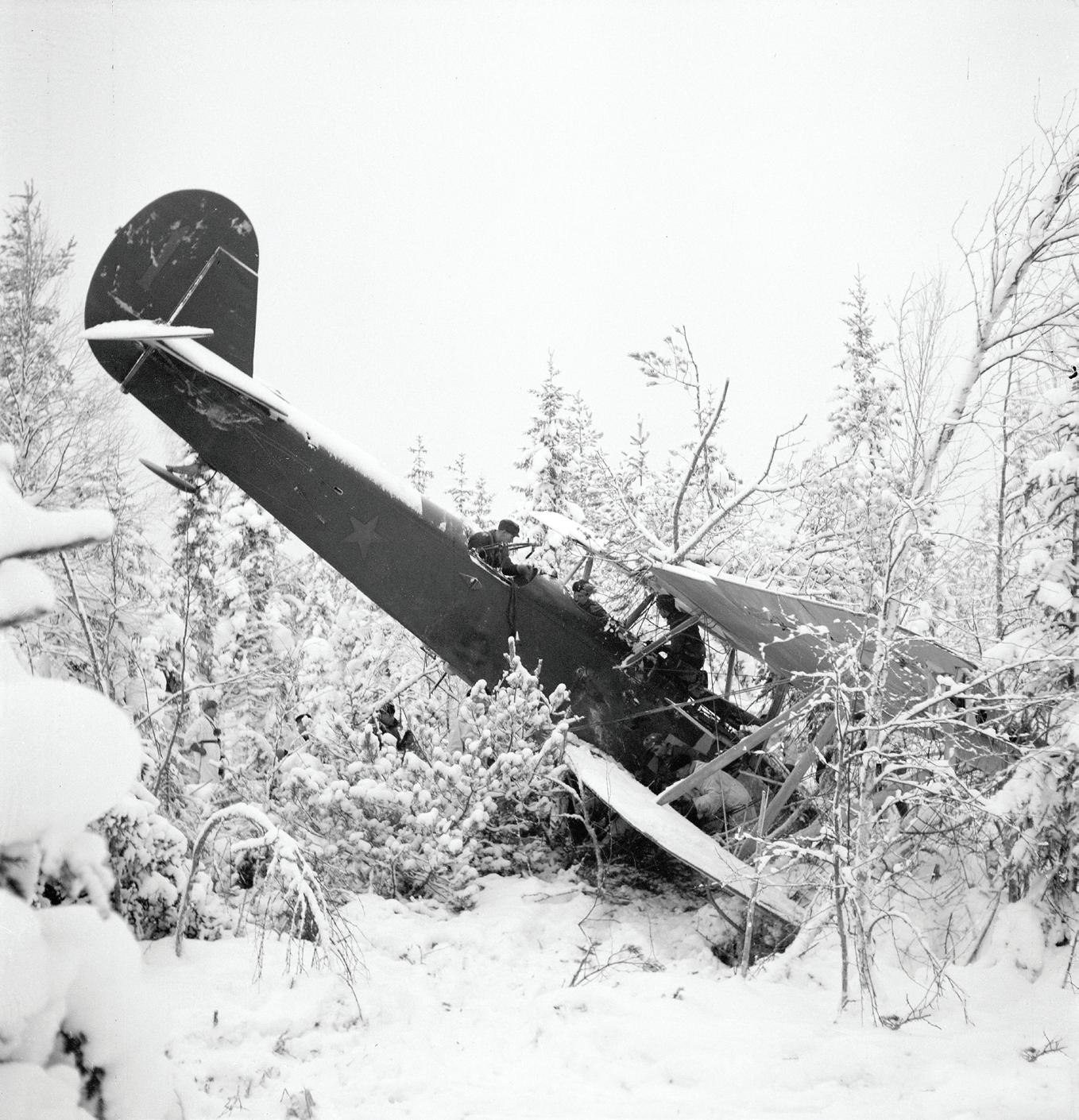
Poor morale, heavy losses from frontal attacks and a shortage of supplies resulted in the Red Army refusing to fight further, resulting in a Finnish victory when the battle ended at the end of December.
Here, the Finnish forces did not have it so good. Outnumbered 3:1 in men, 5:1 in artillery and inferior in air power, the Finns were quickly routed. They retreated to the Kolla waterway where the river itself didn’t present much of an obstacle, but the high ridgeline around it did and this line held until the end of the war.
The Soviets referred to this battle and territory as “the White Death”.
Outclassed and out maneuvered in and around this sector, the Soviet army eventually retreated in order to deploy these resources elsewhere. Once again, Finnish forces proved their mettle against the Red Army.
Finnish high command did not believe the Soviet forces would attack in this region and were quite surprised when they did. The Soviet plan was to push through the rugged wilderness to Oulu and cut Finland in two, separating the south from the north.
Two roads lead from the frontier to Suomussalmi where the Red Army committed two divisions for this task. The Finnish leadership set up a road-
block on the one of the roads and then proceeded to completely destroy the Soviet 9th Division in a series of battles of encirclement. The resulting captured booty of anti-tank guns, hundreds of trucks, thousands of horses, medical supplies and ammunition went far in supplying the Finnish army in what was yet another disgraceful display of military ineptness by the Red Army.
Fighting in the Arctic Circle is an experience in survival, first from the elements, which more times then not, are more deadly than your enemy. Here too, the Finns did not expect much action from the Red Army and here too, they guessed wrong. The Soviets sent two divisions to Lapland totaling 35,000 men where they easily took the town of Salla. However, the highly motivated Finns outflanked the invaders and quickly caused them to retreat. Later, when the Red Army renewed its attacks, they met a spirited resistance in the area of Kemijärvi and retreated yet again to their defensive line in which they occupied until the end of hostilities.
The only area the Finns could not defend adequately was the only major port in their possession, the town of Petsamo in the extreme north. This area
is treeless and windy and has no natural lines of defense. The Finns decided to abandon Petsamo as trying to defend it was hopeless. Their strategy instead was to execute guerilla tactics against the advancing Soviet army in an attempt to simply delay them. These tactics proved very successful and the Finns managed to halt a force five times larger than their own.
The Soviet Air Force began the invasion with 2,500 aircraft of the Tupalov variety compared to the Finnish Air Force of 114 combat aircraft fit for duty. Foreign aid the way of aircraft and other materials came from Britain, France, Sweden, Italy and the United States. Spirit and élan were strictly Finnish and it was the norm for the motley crew of the Finnish air force to fly into battle outnumbered ten and up to twenty to one against the Soviet Air Force. Like their brothers on the ground, the Red Air Force was no match against the Finnish Air Force who bested them in the skies above Finland as well. The Air Force accounted for 200 confirmed Soviet kills while the anti-aircraft guns on the ground shot down 300 more. The adaptable
Finns made use of frozen lakes to improvise as landing fields and forward air bases to skillfully counter the Soviet Air threat.
Josef Stalin was furious with the humiliation of the Red Army at the hands of the Finns. The Red Army lost face on a global scale, and of course, Germany was paying close attention. In classic communistic style, the propaganda machine blamed weather, impregnable fortifications and of course, a 1,000 of the best pilots from the United States, sent to Finland to help.
Stalin ordered the end to frontal assaults and reinforced the Karelian Isthmus with an additional 15 divisions including 7 tank brigades totaling some 600,000 men! Full-scale mockups were set up to practice pinpoint artillery barrages. On the first day of February, a 24hour bombardment began consisting of over 300,000 rounds of artillery on the Mannerheim line.
After 10 days of heavy shelling, the Soviets achieved a breakthrough around the town of Summa on the western side of the Karelian Isthmus. Mannerheim called for a general retreat to a secondary line of defense.
All the while, diplomatic attempts at peace were consistently ignored by the Soviet Union. By the midway point in February, Finnish forces were near exhaustion. Sweden and Germany were both in support of peace negotiations and pushed to have a meeting to bring an end to hostilities. Germany especially wanted to maintain its flow of iron ore from Finnish mines so they had a vested interest. On 25 February 1940, the Soviet Union laid down its demands.
Thanks to both Norway and Sweden for denying the right of passage to British and French troops, artillery supplies almost exhausted and weapons wearing out, the Finnish position was hopeless and Finland gave in to Soviet aggression and demands. The Winter War was over with the signing of the Moscow Peace Treaty, 12 March 1940.
Finland had to cede a portion of Karelia, the entire Karelian Isthmus and the land north of Lake Ladoga. The area included Finland’s fourth-largest
Gulf of Finlandcity of Vyborg, much of Finland’s industrialized territory, and significant land still held by Finland’s military.
This amounted to eleven percent of the territory and thirty percent of the economic assets of prewar Finland. Twelve percent of Finland’s population, 422,000 Karelians, lost their homes and had to be evacuated. Finland also ceded a part of the region of Salla, Rybachy Peninsula in the Barents Sea area and four islands in the Gulf of Finland.
The Hanko peninsula was leased to the Soviet Union as a military base for 30 years. The region of Petsamo, captured by the Red Army during the war, was returned to Finland according to the treaty.
Finland lost 25,000 people during the 105-day war plus thousands more wounded. Of 1,100 prisoners of war, approximately 20% did not return. Air raids killed 957 civilians and the Finnish army lost approximately 30 tanks.
The Soviet Union lost approximately 170,000 dead and 190,000 wounded. Of the 5,572 Soviet prison-
ers of war repatriated to Russia, it is believed the NKVD in classic Soviet style killed 100%.
It is also estimated that approximately 3,500 Soviet tanks were destroyed, and approximately 1,200 aircraft in this display of Russian ineptitude.
Hitler was delighted with the outcome of the Winter War. The Red Army was a disgrace and humiliated across the world. The Soviet Union was thrown out of the League of Nations. Anglo-French War Council proved completely ineffectual and powerless.
Within two weeks of the peace treaty, relations with Finland were at the very top of Hitler’s agenda!
More importantly, the net result of this pyrrhic Soviet victory was that Hitler firmly believed the Soviet Union was a paper tiger that could easily and swiftly be defeated. Leading to the comment in June 1941, ‘we have only to kick in the door and the whole rotten structure will come crashing down’.

The end of the Winter War did not bring respite for Finland. In fact, it was quite the opposite. War shattered their economy. The influx of 400,000 refugees fleeing Soviet occupation of annexed territory further put a strain on the economy.
Worse still, their strategic position was now substantially weaker than at the start of 1939. The taking of Salla caused a wedge to be formed into the heart of the country made it easier for the Soviet Union to pinch Finland off from the north right at the waist of the country. Finland was also forced to build a railroad to Salla that would also facilitate any military operation in favor of the Soviets.
In the far north, possession of the Rybatchiy Penninsula gave the Soviets a dominant entrance to Pechenga while the Hanko base in the south gave them a strong beachhead in the heart of Finland west of Helsinki. The German occupation of Norway completed the circle of isolation and hope of some Western intervention. With the fall of France, Germany was now master of the continent and while all this was happening, the Soviet Union was busy consolidating its hold on Lithuania, Latvia and

Estonia and increasing the pressure on Finland.
Using bully tactics, Stalin demanded all property removed from Hanko, prior to Soviet occupation, (either public or private) to be returned. Soon a new demand followed for Soviet control of the nickel mining at Pechenga or operational partnership with Finland in control of the mining operation.
In July, more concessions by the unrelenting Soviets were forthcoming by way of a demand to demilitarize the Aland Islands and for the rights to send Soviet trains across Finnish territory to Hanko.
It is hard to blame Finland for leaning towards Germany for help. Finland made overtures to the German Foreign Minister. Two key factors worked in Finland’s favor that July: I.G. Farben contracted 60 percent of the Pechenga nickel ore production, thus assuring Germany an abundant supply of a strategic material and Hitler set in motion the planning for the military campaign against the Soviet Union. Coupled with a new incident in August that raised alarm bells when the Soviets entered Bessarabia. The Soviets also started communist
demonstrations in Helsinki and charged that the Finns were attempting to suppress the Soviet supported Association for Peace and Friendship with the Soviet Union. For all intents and purposes, it would appear Finland was the next target in the Soviet sights.
In mid August, Hitler ordered the strengthening of land, sea and air forces in the northern most parts of Norway. Mountain Corps Norway was giving the task of securing the Pechenga nickel mines in the event of a Soviet attack.

Germany-Finnish relations became much closer very quickly in the last few weeks of August when deals were made to allow German Air Force supplies to be moved across Finnish territory to Kirkenes as well as German troops. Goering, in his capacity as director of the 4-year plan secured mining rights to Pechenga. And, Germany also began shipping stockpiles of military supplies and equipment to Finland.
Finland had a new lease on life, even though, tensions remained with the Soviet Union, Finland and Germany well into the first quarter of 1941.
Mannerheim wrote in his memoirs that were it not for the transit agreements with Germany, Finland would have fallen victim to the ever-spreading tentacles of Soviet expansionist greed and would have been occupied by the end of 1940.
On 18 December 1940, Hitler signed Directive No. 21, the strategic plan for Operation Barbarossa and in regards to Finland, the Directive reads as follows as it pertains to Finland:
II. Probable Allies and their Tasks:
1. On the wings of our operation the active participation of Romania and Finland in the war against Soviet Russia is to be expected.
The High Command will in due time arrange and determine in what form the armed forces of the two countries will be placed under German command at the time of their intervention.

3. Finland will cover the concentration of the German North Group (parts of the XXI Group) withdrawn from Norway and will operate jointly with it. Besides, Finland will be assigned the task of eliminating Hanko.
The primary task of Group XXI, even during the eastern operations, remains the protection of Nor-
way. Forces available other than those needed for this task (Mountain Corps) will first of all be used to protect the Petsamo area and its mines together with the Arctic road, and will then advance, in conjunction with Finnish forces, against the Murmansk railway and will cut the Murmansk area’s land supply routes.
Whether an operation of this nature can be carried out by stronger German forces (two to three Divisions) coming from the area of Rovaniemi and to the south is dependent on Sweden’s willingness to make the Swedish railways available for such a move.
The mass of the Finnish army will have the task, in accordance with the advance made by the northern wing of the German armies, of tying up maximum Russian strength by attacking to the west, or on both sides, of Lake Ladoga. The Finns will also capture Hanko.
What is of extreme interest is Hitler’s fixation on capturing Murmansk. Not because he predicted how valuable it would later become in supplying the Soviet Union with vital Lend Lease aid from the Western Allies, but because he feared it would be captured by the British and used as a naval base of operations in the North!
OKH had ambitious plans that included a drive on Petsamo and on to Murmansk supported through Norway. A drive across the middle to retake Salla and counter what they believed to be a repeat of the Winter War strategy which the Soviets used in an attempt to cut Finland in half and ambitious plans in the south around Lake Ladoga-Lake One-
ga and the White Sea. All based on a study called SILBERFUCHS drawn up by the Army of Norway. The plan had its limitations in that it was extremely difficult to assemble a large force in the far north, the operation possibilities were poor and logistics, rear area support and a lack of any form of supply base made ambitious planning extremely difficult and the probability of success very poor.
In the center, the entire operation for a push to retake Salla was hinged on Swedish co-operation to allow the transport of troops and supplies through Sweden so a force could be assemble in Rovaniemi.
Finally, the war aims of the Finns were not totally in line with the war aims of the Germans. All Finland wanted out of the war was to regain the territory lost and maintain its independence. They made it clear they were not in it for conquest. In retrospect a wise decision that very well may have saved them after the war.
In another twist of fate, at the beginning of March, two British cruisers and five destroyers appeared off the coast near Svolvaer and shelled the town, sinking several ships that were in the harbor. Afterwards, a landing party went ashore and took
The raid was of no great significance other than what it did to influence Hitler’s thinking. The plans for the attack through Finland were now changed. This was due to the difficulty in defending Norway against a British attack because of its very long coastline. in Hitler’s mind this made northern Norway an easy target. The plan originally was to release 40 percent of the forces in Norway to be used in Finland. Instead, these troops were now to remain in Norway. Especially since Sweden’s cooperation was still in doubt.
The Murmansk operation was reduced to a campaign of opportunity, if the situation arose whereby it could easily be taken, but no longer a primary objective. Tentative plans were once again drawn up, and not finalized until Finland committed to participation in the middle of June. In a military conference attended by General Heinrichs, Jodl explained Finland’s role. He expected them to enter the war two weeks after the Germans crossed the frontier and make their main push east or west of Lake Ladoga. The Finnish delegation explained that the area in question was of great importance

 200 German merchant seamen and 20 German soldiers prisoner.
200 German merchant seamen and 20 German soldiers prisoner.
to them and therefore, would not just simply wait to attack. Instead, they wanted to concentrate all their strength on the Lake Ladoga front and recapture the land taken from them by the Soviet Union in the Winter War. The also wanted assurances, the Germans would retake Hanko and free it of Soviet occupation.
It was decided that General Falkenhorst (tried and convicted as a war criminal after the war, sentenced to death, later commuted) would command the armies in northern and central Finland while Field Marshal Mannerheim would command all the forces in the south on the Lake Ladoga front.
This two-command system was a fundamental error. According to the teachings of Clausewitz Unity of Command is critical. Why the Germans would allow themselves to fall into this trap is not readily clear. The tasks in Directive 21 were fundamentally clear in regards to Finland but no effort seems to have been made to take it all under one command. Part of the rationale behind this decision seems to be in the belief that the campaign was to be a short one, Finland was a side show and therefore, a very tight co-operation with the Finns was not that necessary.
Heinrichs also warned the Germans not to expect a great deal from the Finnish army. Their objective was to reach the banks of the Svir River and this could only be expected under the most favorable of circumstances. He reiterated his demands that the Germans were to expel the Red Army from Hanko and they would take care of retaking the Aland Islands. Also, he warned the Germans that any attempt to put in a “Quisling-type” government in Finland would result in an immediate end to the German-Finnish relationship.
On 17 June 1941, Finland issued a general mobilization order and all the military arrangements were approved by the Finnish government but only after Keitel authorized the Military Attaché in Helsinki to confirm Germany would abide by the conditions after the war was over.
Germany crossed the frontier into the Soviet Union on 22 June 1941. Finland declared its neutrality, which it maintained until 25 June, when the Soviet Air Force severely bombed a number of cities in southern Finland. In an emergency session of Parliament, Finland justly declared war on the Soviet Union.
Officially at war, the Finnish troops did not set out for their objectives, however, until 10 July.
Moving men above the Arctic Circle in itself is a major undertaking and so it was for assembling the attack forces in the far north of Finland. Mountain Corps Norway had to move 3rd Mountain Division from Narvik to Kirkenes. In the south of Norway, 199th Division, miscellaneous units in the size of several battalions made its way north arriving at the end of May. 2nd Mountain Division was already stationed in Kirkenes. SS Kampfgruppe “Nord” came through Sweden, was transported to Narvik and then made its way to Kirkenes.
There was only one road from Narvik to Kirkenes, Reichsstrasse 50, which was rendered useless as the June thaw made it a quagmire. The roads south of Narvik were blocked in many places due to ice at the ferry crossings of the fjords. All problems that would plague the campaign till the end.
The last elements of 3rd Mountain Division arrived 17 June and reached their assembly areas 17 June, barely in time to march south along the Arctic Ocean highway to Rovaniemi. The Mountain Corps of Norway assault force numbered 27,500 men. Supply from this force came from a 1-year stockpile in Norway that was to be transported by ship as far as possible and in emergencies, they were to come in overland from Narvik via Reichsstrasse 50.
All assembled, XXXVI Corps consisted of 40,600 men and an attached unit of Finns.
On June 23rd, Sweden consented to let German troops travel through Sweden on their way to Finland. It should be noted that although the Gulf of Bothnia and the Baltic Sea were relatively safe for sea transport, the Finnish ports in the Gulf were of low capacity and icebound for 4-5 months of the year coupled with the Germany lack of merchant vessels to maintain traffic from Norway, the arctic ports and the Baltic.
To make matters worse, the Finnish railways used the same gauge as the Soviet railway gauge and were thus incompatible. Rolling stock was scarce and German equipment could not be supplied immediately. Finnish locomotives burned wood and their hauling capacity was low. For example, it took some 70-80 trains to move one German division. The road net in northern Finland was also extremely thin, few roads were of military grade and very few bridges were capable of bearing the 11
load of military equipment. For a truck to make the 600-mile round trip from Rovaniemi to Pechenga required almost the same amount of fuel payload as the cargo they carried.
Northern Finland is a formidable country. The terrain is daunting to traverse, the coast is bare, the rock surfaces gouged and is a jumble of rises and depressions along with giant boulders, rocks and gravel to give added texture to a punishing landscape. Many of the valleys have no outlets and therefore are the basins for hundreds of lakes when the snow is melting. The belt of tundra eventually shades off into coniferous forests of the taiga. Winter here lasts from October to May and is a succession of arctic storms and blizzards.
Summer lasts a little over one month with temperatures ranging from 50-80 degrees F. Winter temperatures can go as low as -45F in the middle and southern part of Finland.
It is in knowing these conditions, the Finnish and German Armies began the Barbarossa campaign.
From 1 to 6 July, the Northern Army launched its attack against the Russian 14th and 52nd Divisions defending the Litsa River line. Stiff Russian resistance, coupled with Hitler’s interference (again, the shadow of British invasion loomed large in his fantasies), the attack faltered. The first 6 days of attacks failed to meet their objectives and some bad luck with a dispatch rider driving into the Russian lines with the battle plans caused the operation to change its axis of attack.
From 7 July to 5 August, Mountain Corps Norway made very good progress destroying one Soviet battalion and forcing the Red Army to go on the defensive. A request for more troops was met with the typical Hitler vacillations and eventually he agreed to send the 6th Mountain Division stationed in Greece.
Even though it was early August, early signs of Autumn were appearing in Northern Finland and quick action was necessary before brutal winter

conditions set it. Optimistically, perhaps, 1-2 good months of campaigning weather was left. Either the Germans got to Murmansk before winter set in or they would have to retreat.
Again, lady luck played against the Germans as Mountain Corps Norway organized for the final push, a Soviet submarine attack sank two transports carrying reinforcements and a British naval attacked delayed another two convoys with the lose of one of the escort ships protecting them.
To make matters worse and cast doubt on the wisdom of this military adventure, GeneralOberst Dietl warned Jodl even if the operation was a success and Murmansk was taken, Murmansk could not be supplied. The preconditions for being able to keep Murmansk supplied were such that the railroad north of Kandalaksha would have to be captured and there was little hope that supplies could be brought in by land or by sea during the winter months from Pechenga.
In July, answering the call for help from Stalin, the British sent a fleet consisting of two aircraft carri-
ers, two cruisers and six destroyers to conduct a bombing raid on Kirkenes, Pechenga and Liinahamari. The result was a very high loss in planes and no enemy shipping was damaged. In August, two aircraft carriers and two destroyers sailed to evacuate the inhabitants of Spitzbergen and to destroy the coal mines. On the trip home, they sunk a German escort ship. And, at the end of August, one aircraft carrier and two cruisers escorted an old aircraft carrier to Archangel and on the return trip, sunk a freighter. These naval expeditions by the British were considered to be a waste of resources by the Admiralty. Their only justification was that it served a political purpose by showing a visible and tangible effort to help the Soviet Union in their cry for assistance.
However, unbeknownst to the British, the attacks had a completely different effect on the German High Command. On the ground, the German and Finnish troops were reaching the end of their tether. Supplies were critically low, the troops were exhausted and no prospects of resupply or relief were in sight as winter approached. A general retreat was called and the troops retired to build a winter line on the outskirts of Pechenga.

This campaign in northern Finland ran its course from the start of the war to about the middle of September. In the two and a half months of combat, the Mountain Corps Norway had 10,290 casualties and advanced a total of approximately 15 miles in the rugged and unforgiving arctic terrain.

From the beginning, it was doomed to failure due to vague and directionless planning and by not committing more forces from the divisions stationed to guard Norway, as previously discussed. The forces committed to the attack were simply not enough and the logistics required to maintain these forces simply broke down under the strain of arctic conditions and misfortune at sea when resupply was attempted. OKW had made a false appraisal of the environment, the capabilities of their task force and especially, of their enemy.
The Germans were hard pressed as a result of the environment turning hostile, the two roads lead-
ing to Pechenga (Reichsstrasse 50 leading in (400 miles) from Narvik (400 miles) and Arctic Ocean Highway leading in (300 miles) from Rovaniemi simply did not have the capacity to deliver supplies and the sea lanes were freezing over. The Soviets on the other hand had the Murmansk Railroad which could readily bring up replacements and supplies. Dietl admitted that no matter how reinforced, the seemingly endless supply of men and material the Soviets were pouring in made the task of seizing, occupying and holding Murmansk almost impossible.
.
The Salla region is the spearhead shaped area pointing towards Sweden in the heart of Finland. This is the area taken from the Finns in the Winter War and the focal point of attack for XXXVI Corps and the Finnish III Corps and in reserve, the Finnish 6th Infantry Division. It is also the point where the Soviets built a rail line to the new border and the Finns were just completing their new section.
They had dragged their feet on building the line until they had new purpose for it, seeing that building it before allying with Germany only benefited the Red Army, if and when they decided to attack again. Now, it could be used against the Red Army and they sped up the building process.
In doubt, the capabilities of the SS “Nord” Division made up of Swedish volunteers. The commanding general of XXXVI Corps, Feige want to keep the SS Division back but was ordered by Army of Norway command to include it in the attack.
The Soviets had fortified the border making it a major strong point defended by an infantry division and approximately 50 tanks.
The goal of the Germans and Finns was to drive a wedge deep into the territory and take the Murmansk rail line after attacking the border wedge from both flanks, encircling and destroying the forces first, then moving to block the rail line.
On 1 July, the Finns crossed the frontier after an air bombardment and artillery fire. However, fires started from these bombardments created a massive amount of smoke that greatly reduced visibility and hindered the advance.
On this day, the SS Division was a disgrace on the battlefield, with units retreating in disarray. In disgust, Fiege order them to assembly again on the border and take up defensive positions.
With new orders, the SS division set off again only to be later scene completely routed as they retreated at full speed claiming Russian tanks were in hot pursuit. In reality, they heard the Soviets start up some tanks and then counter battery fire against their artillery to retaliate in kind. The SS mistook this as a tank attack and ran in full-scale panic.
Salla fell to the Germans 7th but the Red Army had conducted a skillful retreat, having seen the development of an encirclement in the making. A substantial amount of war booty was left behind, but the army retreated in good order.
Overall, like the northern front, progress was slow, due to terrain and resistance and every day, the Red Army was sending in reinforcements from the port of Kandalaksha. In one month of fighting in the sector, XXXVI Corps managed to advance slightly more than 13 miles at a cost of 5,500 casualties.
By 25 August, XXXVI Corps had a major success
in dislodging the Red Army and began to chase them as they tried to escape being encircled. The retreat culminated in the Germans advancing to the Verman River line, a fortified position from the Winter War and stalled. Behind this line and leading back to Kandalaksha, the Russians were using forced labor of mostly women to build three more lines of fortifications.
The problem in this sector, as described by Feige was that opportunities were being missed to encircle and destroy the Red Army in front of them from lack of troops. By 8 October, as bad weather was setting in, all operations were stopped. Orders for troops to be reassigned were issued and little hope for advancing to Kandalasksha remained.
After three and a half months of fighting, the entire efforts of the Army of Norway and their Finnish Allies, the entire operation was bogged down. The cost so far was 21,501 German and 5,000 Finnish casualties and any prospect for a successful future outcome was very dim.
Finnish operations in Karelia began in earnest 10 July and met with success pretty much everywhere. The only disappointment in the early phase was the lack of ability to close the gaps in encirclements allowing many Red Army forces to escape. Mannerheim was very clever in his operations and conducted his offensive with the primary goals of retaking lost territory and not really being interested in exploiting deep into Russian territory. A pessimist by nature, he was also not impressed with German progress and didn’t see an easy victory in sight for his ally. As such, he stuck to his game plan of advancing Finland’s goals over German interests.
He further soured at the lack of progress made by Field Marshal von Leeb, when Army Group North failed to establish contact with Finnish forces north of Leningrad in the Lake Ladoga area as planned. At the time of Army Group North’s advance towards Leningrad, Hitler was full of expectation as the city was his most important target. So much so, he was prepared to detach 3rd Panzer Army from Army Group Center to lend weight to the speedy capture of Leningrad and the linking up of forces with the Finns.
Hitler’s plan for Leningrad bordered on the absurd and may well have played a factor in saving the city in the end. He was of the opinion that the breadbasket of the Soviet Union laid in the Ukraine. This region was to be spared to produce agriculture, raw materials and industrial output.
Leningrad was viewed as a concentration of useless mouths to feed and therefore expendable.
He also viewed Leningrad as a very important symbol of nation to the Soviet people and intended to destroy the city for all time. However, he couldn’t decide how to take it. In his insanity, he thought of schemes like encircling the city as tightly as possible, then surrounding it with barbed wire and machine gunning anyone who tried to leave, in the meanwhile, leaving everyone inside to starve.
Another idea was to let out all the women and children and let them loose on the Russian lines to cause confusion and panic in the rear, and to over burden the area with their care. In theory, this was a difficult plan to execute and the Soviets were insensitive to the suffering of their people. It would most likely have failed.
Since the level of depravity in dealing with Leningrad couldn’t be decided, it was determined that no German unit was to enter the city, but only to encircle it. Also, von Leeb was to not accept an offer of surrender from the city or units inside the city. So, it was determined to isolate Leningrad, cross the Neva and link up with the Finns around Lake Ladoga.
Keitel presented the plan to Mannerheim, who was to cross the Svir River and head south to meet up with the Germans. This plan drew a very cold reply

from Mannerheim. He had made no agreement to aid the Germans in the taking of Leningrad much less go past the old borders of Finland as they were before the Winter War. Leningrad especially was a very sensitive topic with the Soviets and the whole reason they attacked Finland in the first place was to take a buffer zone to protect the approaches to the city. By accepting Keitel’s plan, he would be feeding into, for all time, the substance of this claim if he participated in the taking of the city. This was for the Germans, and Germans alone to execute this plan.
Also, Finnish losses had been high so far in the campaign, their economy was in tatters and manpower shortages were wide spread. Urgent warnings were being issued to Mannerheim from leading industrialists as well as the President of the country of the dire conditions the country was in and not to expand the military manpower, as these bodies were needed at home to help with the economy. Mannerheim also distrusted the Germans and felt they would advance to the Volkhov River and then leave the responsibility for the capture of the rest of the territory around Lake Ladoga to the Finns.
As can be imagined, this waffling on the part of Mannerheim was very disconcerting to OKH. It therefore issued orders to Army Group North to proceed as quickly as possible to advance and
establish contact with the Finns. October and November rains very quickly put a damper on the operations and by 1 December, the Germans were spent and all offensive operations were postponed further until some time in 1942.
There was no continuous front line in northern Finland, as there was in mainland Russia. Inadequate supply lines made that impossible. Conflict centered on important choke points that were close enough to supply lines.

In the very far north, battle raged in the vicinity of Petsamo and Murmansk. At the bottom of the Kola Peninsula around the region of Kandalasksha, the Germans and Finns put on a desperate struggle to cut off the Murmansk rail line.
Just north of Lake Onega, the Finns made a good show of cutting off the Murmansk rail line but this was moot as the Soviets built the Murmansk Emergency Rail Line and the flow of men, equipment and supply continued uninterrupted.
On the Sea, the Germans were as disorganized as on land. Due to distractions elsewhere on the Eastern Front, Hitler did not pay enough attention to Allied shipping efforts. Also, a lack of fuel and a reluctance to risk the Tirpitz, the Scheer and the Prinz Eugen on convoy deterrence, the Allies
continued to bring in supplies to Murmansk and Archangel. Raeder rightly surmised that to be really effective, the Navy needed the presence of the Graf Zeppelin aircraft carrier that was expected to sail in 1943. Until them, the battle groups primary mission was to thwart any invasion attempt by the British.
In 1943, there was a shaking of confidence when the Soviets opened a 6-mile corridor to Leningrad and the news of Stalingrad broke. Mannerheim requested Dietl release five Finnish battalions from his command. Hitler doggedly was hanging on to Pechenga and the nickel mines, but little else could be accomplished by way of any renewed northern offensives. A turning point had been reached and Mannerheim and the Finnish government had decided to find a way out of the war as they saw the writing on the wall.
The Battle of Kursk, pressure on Army Group North and their apparent and imminent withdrawal from Leningrad left the Finnish looking for diplomatic solutions that now started to have an impact on the battlefield. For the first time, the Germans and Finns had a numerical superiority over the Soviets and the Germans wanted to exploit this. However, a clearer thinking Mannerheim without a doubt saw that even a push in Karelia, cutting off the Murmansk rail line and relieving pressure on Army Group North was all temporary and would in the long run, produce more harm than good to Finland when the war came to its inevitable conclusion. The end of 1943 closed with a measure of stability but no prospect for any future success.
In 1944, the Germans started looking at invading Sweden in an effort to better supply the armies in Norway. All the posturing and planning and preparations were in vain as the events after Kursk drained all resources to other fronts.
1944 saw the liberation of Leningrad and Finland started making serious moves for peace. The summer of 1944 brought renewed Russian offensives that pushed the German and Finnish armies back into Finland and the loss of Vyborg greatly impacted Finnish morale on the field and on the home front. On 1 August 1944, Mannerheim took over as President of Finland. The Allies by this point were breaking out of the bridgeheads in Normandy and for all intents and purposes, the war was over. On 29 August, a delegation from the Soviet Government offered an olive branch and Finland accepted the conditions.
On 18 September 1944, after some wrangling and heavy pressure from Russia, an Armistice was signed and Finland withdrew from the war.
reading. Thanks to their efforts, this product will largely be free of errors.
The idea of this expansion has been brewing in my mind since I designed Russia Besieged but really gained momentum with the Deluxe Edition. When I published the L2 Design Group version, the turn chart (and some play aids) was located on the Finnish side of the map. When I collaborated with Compass Games, LLC., to put out the Deluxe Edition, I left that side of the map unencumbered and went with a standalone turn chart. I had been thinking about an expansion map for years to complete the East Front, so to speak, and decided I would do it with this edition.
I have tinkered with this project on and off for some time and then along came Paul Popejoy and I was seriously off to the races motivated to get this done. I should also be remiss if I did not thank Bill and Ken at Compass Games. I never missed an opportunity to do so as they are a pleasure to work with. In my opinion, they have gone
The Continuation War in Finland was more steeped in history than in sweeping battles, armor penetrations and history turning moments. It started off with a lot of promise and petered out pretty quickly and then stagnated until 1944. Finland is a brutal country to fight a war in!
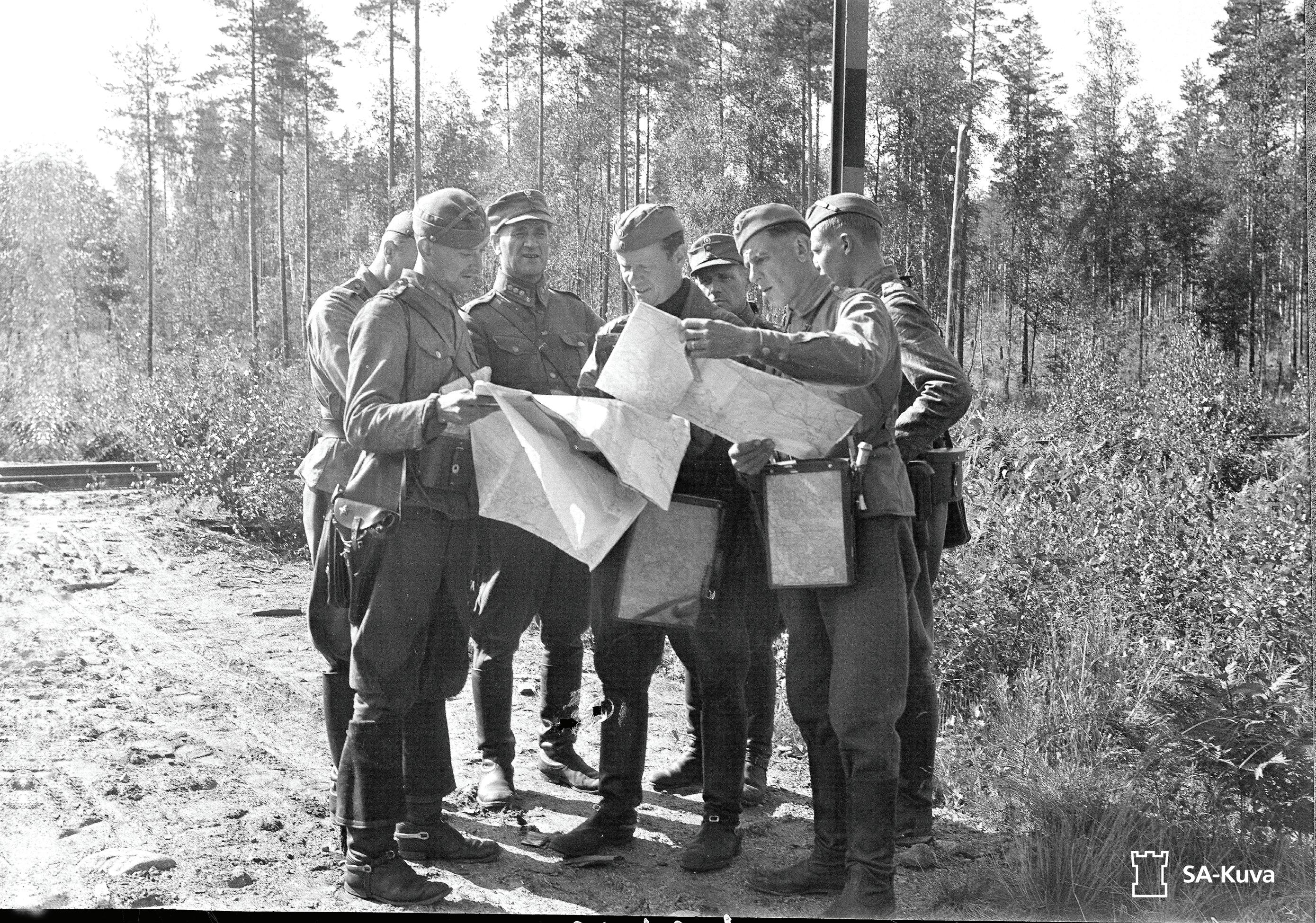
For starters, one third of the country is above the Arctic Circle and is referred to as Lapland. The terrain is rugged, thick forests, rocks of all shapes and sizes, lakes, rivers, valleys filled with melting snow runoff, snow storms and a lack of towns, roads and rail lines. Ideal country for conducting military operations it is not!
Moving from point A to point B in Lapland is a war in itself. The terrain is extremely difficult and time consuming to traverse. Add an opponent shooting at you, mix in some freezing weather and no logistical network to keep you supplied and you have a recipe made for disaster.
In some places, summer is 6-8 weeks long where
the temperature runs from 60-80 degrees. In other areas, the temperatures can get to as low as -45F. It is a country where only the hardy and the brave choose to live.
I am not sure that the scale of the game lends itself well to an Army/Corps level game. But the more I thought about it, the more I thought not only was this a doable project, but it would add some flavor and challenges to the players of the game. It is a front that has to be maintained, but only by so much. The German wants to cut off Murmansk. The Russian player needs to hold it. If Murmansk is cut off, not all is lost because the Russian player still has Archangel. There is a loss of Lend Lease, but is it worth expending mountains of troops to protect it? It is up to you to decide what you can spend, and how much you are will to spend to either take the territory or defend it.
So, I thought this would make for an excellent expansion on a few levels:
1) it historically expanded the game to the total theatre of operations of the Wehrmacht on the Eastern Front. The counters needed for the Order of Battle were mostly there, the Expansion only required a few more. It also game me an opportunity to do some extra counters for the First Turn Player’s Guide.
2) It allows the more serious player to learn something new about Finland and how they have been bullied by Russia for two centuries and have managed to remain independent, democratic and free of the Communist/Russian yoke.
3) The expansion will allow you to learn more about what lead to the thinking that “all you had to do was kick in the door …”, and start Operation Barbarossa with such high optimism based on faulty facts.

You can see why Hitler thought the Russian adventure would result in easy spoils and vast territories in a short period of time. After all, a small country that was outnumbered 3:1 stalemated a lumbering army, kept it at bay for three months and inflicted very heavy losses of men and material, it was no wonder Hitler thought the mighty German War Machine would easily cut through the Soviet Union and destroy the apparently hapless Red Army.
He would be sadly mistaken.
So, for those of you who are expecting sweeping panzer movements, encirclements, massive attacks with big stacks … this front is not for you. The first and second year saw some activity and then the war pretty much fizzled out on this front. The terrain is too punishing, movement is next to impossible and a good supply line is a pipe dream. You can of course, make what you want of it, that is the beauty of wargames.
I hope you enjoy the Expansion Map, learning the history and talking about it online. Thank you, for purchasing my product.
Design:
Art Lupinacci
Cover Credit:
Paul Söderström
Art DirectorGraphics:
Art Lupinacci
Historical Research:
Paul Popejoy
Art Lupinacci
Proof Reading:
Art Lupinacci
Paul Popejoy
Tim McNeil
Pubished under a Licensing Agreement with Compass Games, LLC
Copyright © 2020, Art Lupinacci All Rights Reserved
Acknowledgement and special thanks to: Finnish Armed Forces photography Archive


1.01 Troop dispositions on the Expansion Map
At the friendly players discretion all units are allowed to deploy onto the Expansion Map (hex row x01nn to hex row x18nn).
NOTE: My original intention was to restrict the deployment of certain units to the Expansion Map. However, after some thinking and discussion with Paul Popejoy, we decoded that all units be allowed to deploy on the Expansion Map. Historically, there was some armor and Cavalry that was deployed. Not enough to consider at the Army/ Corps level. The terrain was so punishing that their deployment would not have been effective had they done so. We agreed to allow players the freedom to find out why that is so!
IMPORTANT: ALWAYS reference rules in this section with the LETTER “F” when discussing Finnish Expansion Rules. Example: F 7.0 Partisans
F 2.0 Invasions on the Expansion Map
2.01 No Invasions are allowed on the Expansion Map North of the Arctic Circle line. If Leningrad falls to the Germans, the Russian player may no longer conduct invasions in the Gulf of Finland, Black Sea or Gulf of Bothnia.
2.02 For the Gulf of Finland through to the Gulf of Bothnia coastal hexes, regular invasion rules apply. See Rule 8.4.
F 3.0 Lakes and Rivers on the Expansion Map
3.01 All rivers and lakes on the expansion map freeze in January, return to normal on the first “Clear” weather impulse of the year, and re-freeze for the remainder of the year on the first “Frost”, “Snow”, or “Blizzard” weather impulse in the following October – December.
3.02 Frozen rivers and lakes have no effect on zones of control influence, movement, or combat.
3.03 Rule A 5.0 Frozen Lakes and Rivers in Effect.
3.04 Lakes that do not occupy a full hex are treated as a river hex spine with this rule set applied to combat treatment.
3.05 All ZOCs are treated normally as if no river was there.
4.01 The German player is considered in Combat supply for all units sent to the expansion map. Treat as German Mountain or Finnish units for Combat Supply purposes as per Rule 13.71.
4.02 All Russian units are always in Combat Supply as per Rule 13.71.
4.03 The Axis Forces draw limited general supply from the following hexes:
Hex x 0406 Norway (Reich Stre. 50) 1 corps
Hex x 0603 Norway (Kirkenes) 1 corps
Hex x 0703 Finland (Petsamo) 1 corps
Hex x 1011 leading into Sweden 1 corps
Hex 0318 Helsinki (Unlimited Supply source)
4.04 General Supply works as per Rule 13.0.
5.01 German units that are forced (through adverse combat effects only) to retreat into Sweden are removed from the map. They are returned on the next turn and placed in Narvik and may move back into Finland from there.
5.02 No Russian or German unit may move into Sweden during their movement portions of the turn. Any unit that purposely moves through Sweden is removed from play permanently. [Exception: See Rule 70.04]
6.01 At the start of the July-August 1944 Russian Turn, place the Russian 7th Bomber unit in any minor city on the Finnish Expansion Map in Russian control.
6.02 The 7th Bomber must be based and conduct all missions on the Expansion Map until Finland is out of the war and no German units remain in Finland, at which time it may be based and conduct missions on the main map.

7.01 Partisans my not deploy on the Finland Expansion Map.
Note: Historically, partisan warfare in Finland occurred mostly in Finland itself and Karelia. Partisans were not local, but were assembled from all parts of Russia and deployed in the area. Primarily, they fought behind the Soviet lines. When they attacked, a small percentage of the attacks were against Finnish troop supply and communication columns.
At least 2/3 of their activity in Finland was directed at Finnish civilians, targeting mostly women, the elderly and children. Once captured and interrogated most of their captors quickly executed the prisoners/captives. Typically, Finnish Officers stood a better chance of surviving capture a little longer than solders as they were sent rearward to be “properly” interrogated. Once interrogated, they were executed as well. Not surprisingly, Soviet citizens in Karelia reported partisan activity to the Finns and did not support the partisans.
Also, whatever partisan activity there happened to be was largely ineffective due to the make up of these partisan units. Many of them were conscripted criminals who could not effectively operate in these harsh northern conditions. The Finns themselves were also very effective in their anti-partisan activities and wiped these units out quickly.
Available: At Start
Remove: Start of Turn 21, or Remains, as long as Leningrad is German controlled
8.01 Field Marshal Mannerheim is available as part of the “At Start” forces but may only be used for attacks by Finnish and German units in Finland and no further than hex row 10.xx (see Rule 25.2).

F 9.0 Army of Norway
Norway was to be defended with seven divisions made up of LXX Corps with 3 divisions with its Headquarters in Oslo and XXXIII Corps made up of 2 divisions with its Headquarters in Trondheim. As well, it had 160 batteries of Army coastal artillery, 56 batteries of naval coastal artillery, 6 police battalions, an SS Regiment and 3 motorized machine gun battalions. All in all, about 150,000 men. Prior to the British raid on the northern Norwegian fishing town of Svolvaer, Hitler was going to allow more troops from the Army of Norway to be loaned for the attack in northern Finland. This rule gives the German player some flexibility In the event of an emergency to get some extra troops.
8.02 Dietl is available “At Start” and may be used only on the Expansion Map with both German and Finnish forces. He may be moved to the Main Map only if Murmansk and Leningrad are German Controlled. Removed from play at the beginning of turn 20.

9.01 The German player can activate the 33rd Army Corps, which is located off-board at Trondheim, Norway, for service in Finland at the start of any German turn.
9.02 Activating 33rd Army Corps permanently increases the City Victory point requirement under the Sudden Death Victory rule (Rule 27.0) by ONE starting in the current year and for each of the subsequent years, with the following effects:
1942 18 Major Cities are required
1943 11 Major Cities are required
1944 6 Major Cities are required.
9.03 Once activated, the German player may attempt to bring the 33rd Army Corps on the board by one of two methods:

By using sea movement (Rule 8.0) to have the unit appear at Kirkenes (X0603) or Petsamo (X0703) on the impulse in which the unit activates, or By using off-board movement to have the unit appear at Oulou (X1312) on the impulse after the unit activates.
9.04 If the unit uses sea movement, roll on the Sea Movement table using the sea movement rules and die roll modifiers with the assumptions that Trondheim is a German naval base and that if the


in Finland is deep and plentiful. Storms can be unbearable and temperatures in some parts can go as low as -45F. Combination of extreme weather.




is when the ground is frozen solid and for all intents and purposes, Lakes are frozen, rivers are frozen and snow is plentiful, but conditions are good.




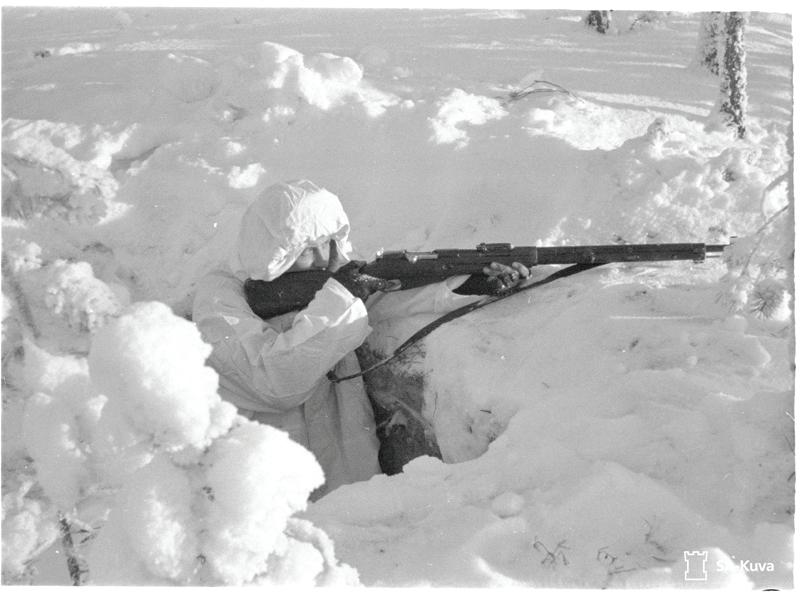
Light Frost is when there may be snow on the ground and roads may be a muddy quagmire. Movement is difficult, cold and very slow. Combination of all types weather.
Clear can mean many things. It can be cold, but conditions are ideal for good road and rough terrain movement. Skies are sunny and ideal for Air activity.

sea movement aborts the unit will return to Bodo (X0215). From Bodo, it can attempt sea movement on a subsequent turn under this rule, or use offboard movement (Rule 70.05) to move to Finland.
9.05 If the unit uses off-board movement, place the unit counter on game board in the “via Sweden” box on the impulse the unit activates, and place the unit at Oulou (X1312) on the impulse after it activates. Placement at Oulou constitutes the unit’s movement for that impulse.
9.6 Any units transferring by sea must roll on the Sea Movement Table. See Rule 8.0 in its entirety.
10.01 The Expansion map has its own Weather Table that functions identically to the main Weather Table for the standard game. The mechanics for determining weather are identical. At the start of every turn, the German player announces he will roll for weather and throws ONE die.
Have both charts in front of you and apply the same die roll to both charts and mark the weather on the turn chart for the main map and in the Expansion Weather Box on the Finnish Expansion Map. Due to Finland having 1/3 of its geographic mass in the Arctic Circle, weather in northern Finland is slightly different than on the main map but the mechanics are all identical.
Consult the Weather Table that came with the game for weather on the main map, and the Weather Table that came with the Expansion for weather on the Finnish Expansion map.

The following rules apply for the Expansion Map and supersede the General Supply Rules in the Standard Rule book:
11.01 There is no restriction to the number or type of units that may be on the Expansion Map provided the units can trace a general supply path.
11.02 Above the Arctic Circle, the gray dotted line on the map, there are very few settlements, virtually no roads, no adequate rail lines and terrain that is rugged and difficult. Transporting sufficient logistical support to keep a corps battle worthy is extremely challenging.

Supply for German and Finnish Corps north of this line is drawn from northern ports and roads. See Rule 65.03. Murmansk may supply any 4 Russian units and the Murmansk rail line provides unlimited supply from the point it leads back, unblocked, to the friendly board edge.

11.03 Units out of general supply at the end of each friendly turn lose one step every turn until eliminated.
11.04 The supply line (Rule 13.2) for a unit above the Arctic Circle varies with the weather:
• Clear weather, 5-hex supply line to a supply source
• Light Frost or Frost, 3-hex supply line
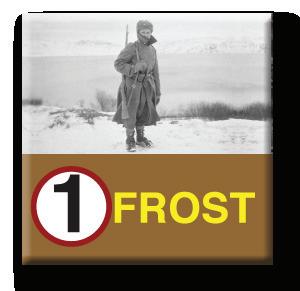

• Blizzard, 2-hex supply line

Blizzard is a combination of snow, wind and extreme cold. The worst of all Arctic conditions.


The Finns and the AOK were very adept at setting up airfields in open fields, on frozen lakes and near any towns where the ground conditions were favorable. In almost all cases, these airfields were small and could not operate on the same scale as those on the main map.

12.01 The German/Finn X Bomber Unit may only fly on the Expansion map until Murmansk and Leningrad are taken. It may then redeploy freely anywhere on the map (Expansion and Main Maps). This rule supersedes the main German Order of Battle Card.
12.02 All AOK and Bomber units in Finland are free to leave and be deployed elsewhere when the German player controls Murmansk and Leningrad. The Finns must adhere to Rule 25.2.
Historical Note:
Unlike Germany, Finland’s only interest in participating in Operation Barbarossa was to regain territory stolen from them in the Winter War. Their primary goal was to retake that territory and remain a democratic country free of the Russian yoke. Finland was not interested in Germany’s military goals and cleverly resisted getting involved (both militarily and ideologically) throughout their participation in the war.
Due to limitations to the size of airfields, the distances involved in moving in supply and material and the extreme conditions in which this theater of operations is located, use the following rules:
A maximum of 2 Bombers may be deployed and have Air Bases on the Expansion map.
Enemy units that are within range of Helsinki but are on the Expansion Map may be attacked by the Bombers based in Helsinki in full co-ordination with AOK and Finnish units on the Expansion Map.
12.04 Only a maximum of 2 Finnish Air Bases and Bombers may operate on the Expansion Map. One of the two must be the X variant Bomber Unit.
12.05 The same applies to the Russian player as long as one of the Bomber units is the 7th Bomber unit, it may deploy up to two bomber units on the Expansion Map.
12.06 Bomber units that are base in Helsinki and Leningrad may freely support attacks by friendly units on the Expansion map, within their range.
12.07 Units from the main map flying combat on the Expansion map may only fly if they are eligible to fly on the main map that turn. Their combat flight counts as a regular combat flight towards any air allocation totals.
12.08 As long as weather permits a minimum of one Bomber may fly on the Expansion Map and any number of Bombers from the Main Map that are in range may participate in an attack.
13.01 Rail capacity for railing into or out of Finland is one unit per turn, regardless of weather.
13.02 The rail capacity of one supersedes Rule
7.0. Once German units enter Finland proper, only one unit per turn may rail, either in the first or second impulse. Finland proper is defined as the landmass between Helsinki and Petsamo inside the red border line. The Soviet territory outside of the Finnish border is treated as part of the German rail allotments as described in Rule 7.0. Rail lines in Finland cannot be converted to German gauge.
13.03 German units may rail in from the main map up to hex row 01xx, any rail past that and onto the Expansion Map counts towards the Finnish rail capacity in order to continue railing. If that rail capacity is used, then the railing unit stops at the map edge.
At the start of Turn 12, the weather die roll is a 2. On the Expansion Map: LT FROST/CLEAR On the Main Map: Lt MUD/CLEAR




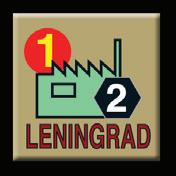

On the Expansion Map, 1 Bomber is available and can fly in either impulse. On the Main Map, 1 Bomber is available and can fly in both impulses as well. So, the German could fly the “X” Bomber in the first impulse, the “I” Bomber in the 2nd impulse. Or, he could fly both Bombers in the 1st, or both in the 2nd impulse against 22nd Infantry.
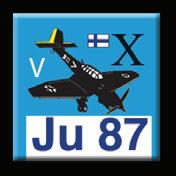

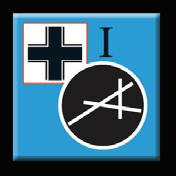
NOTE: “I” can fly to Expansion Map, “X” cannot fly to Main Map.



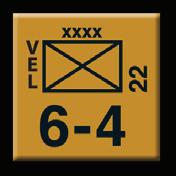





Historical Note: Finland used the same rail gauge as the Soviet Union!




In the Example above, 49th Mountain has railed through Leningrad and wants to stop at either hex x1811 or hex x1713 (marked with blue X&Y). Both of these hexes are on the Finnish Expansion Map. The German unit is railing in from the main map. It is using the main map German Rail allotment as per the German Rail Capacity Chart found on the Play Aid Card. If, the Finnish player has used his 1 rail allotment during the movement phase, the railing unit must stop at either hex 0111 or hex 0414 (with the red HALT stop signs) and proceed no further. If, on the other hand, the Finnish player did not use his 1 rail allotment, then the German player continues to either hex marked “X” or “Y”. He expends his German rail capacity, and also expends the Finnish rail capacity. No further units may rail on the Expansion map. Note, as long as the German player has rail capacity on the main map, other units (like the 1 Infantry Corps in hex 0714) may rail up through Leningrad but must stop on the hexes marked with the red “HALT” sign.
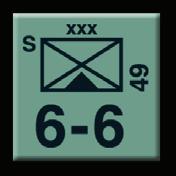






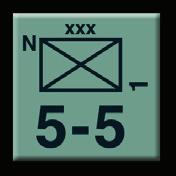


13.04 In order to manage rail movement on the Expansion Map, we have included a Rail Management Box on the lower left hand corner. Place the Finnish Railhead marker in the box when rail is available. When the Finnish or German player uses the one rail allotment on the Expansion Map, remove the Railhead counter from the box.
The core game of Russia Besieged has not changed with the introduction of the Expansion Scenario. The Expansion Rules cover special situations that make play in the geographical area represented by this scenario fit into the overall game system while adding a unique flavor and distinction to the geography and the challenges that came with operating in this theater.

If there is an area of the rules you are uncertain of or a situation arises not covered in this body of work, always refer back to the main rule book for the answer.
When
Flip
13.05 At the start of every turn, place the Railhead marker in the Finnish Rail Available box. Remove the marker when you rail one unit and repeat this process every turn until the game ends or Finland is knocked out of the war.


13.06 Rail lines in Russia proper always convert to the German gauge. That includes the rail line running from Archangel through to Murmansk.
14.01 Refer to Rule 8.0 for Sea Movement mechanics on the Expansion Map.
14.02 Treat the Norwegian Sea and Barents Sea as one area, separate from the Baltic Sea, Gulf of Bothnia and Gulf of Finland which is another entire separate area.
14.03 All Sea Movement attempts are resolved on the Sea Movement Table.
14.04 Sweden is a neutral country. Swedish ports are not factored in to any part of game play other than what is stated in these rules for allowing German transport.
14.05 Archangel shares the same body of water as Murmansk and Petsamo and therefore is consider to be a port on the Norwegian/Barents Sea for sea movement.
Counters may freely set up on any hex in the colored zone.






The Continuation War Scenario is design to give the players both an introduction to the Finnish Expansion and an understand for the heroic struggle of the Finnish people to take back from the Soviet Union, land that was taken from them in the Winter War.
















X X X X X
(Each unit pays 1 Movement point to enter any Hex marked with an “X”)






The battles in Northern Finland were the worlds first battles in the Arctic Circle and for enduring conditions in weather that is close to the harshest to be found on the planet. Military scholars continue to study the battle to this day.
Players should set up the one map scenario and play it through a few times to learn the nuances of fighting in this rugged territory. During the war, Finland and the German Army of Norway fought extremely aggressively in the opening months of the war but the assault quickly slowed down and stopped as the weather changed. Aside from a few offensives in 1942, the Finnish front stabilized and remained generally inactive.
Place the map on a flat table top and take only the counters need from the main game for this scenario. Set them up on the map according to the map setup and Order of Battle restrictions.
All rules for the Finnish Expansion are in effect. For supplemental rules, please refer to the Main Rule Book for Russia Besieged Deluxe Edition for further clarification.
1.01 Start of Introductory Scenario
This scenario starts when the Finns enter the war as per the rules in the main game. All main game rules are in effect.
All game play on the expansion map is dictated by the Rules in the Finnish Expansion.


1.02 Scenario Length
The scenario lasts from the 2nd Impulse of Turn 1 through to the end of Turn 4 (Nov/Dec 1941).
2.0 Victory Conditions
Introductory Scenario
2.01 The German player wins by blocking the rail line anywhere from Murmansk to hex 0812.
2.02 The Russian player wins if he can trace a continuous path along the rail line from Murmansk to hex 0812 free of German ZOC.
Intermediate Scenario
2.03 The German player wins if he captures and holds Leningrad until the end of Turn 10.
2.04 The Russian player wins automatically if he can capture and hold Helsinki for one full turn after the turn of capture.
2.05 Victory Conditions 2.01 and 2.02 also apply.
Use the Standard German Victory Conditions when playing with the entire map.
3.0 Russian Reinforcements
The Russian player, when using the Expansion Map only to play a scenario, receives reinforcements in the following manner:
Roll one d10 die and consult the following table:

Die Roll 1
2-4
5-7
8-9
10
3 WEC Replacement Points which may be accumulated
4.0 Russian Reinforcements:
The Russian Player receives the following units through the course of play (apply only for the Introductory and Intermediate Scenario, for the Campaign game, use the Russian Order of Battle Card and standard methods of play in relation to the Russian War Economy rules):

Turn 1: May
1x 5-4 Infantry Army Rail in from the East
1x 3-6 Mech Corps Rail in from the East

Turn 2 July
1x 4-4 42 Infantry Army Starts in Leningrad
1x 6-4 Infantry Army Rail in from the East
1x 4-6 Mech Corps Rail in from the East
Turn 3 September
1x 4-4 55 Infantry Army Starts in Leningrad
1x 6-4 Infantry Army Rail in from the East
Turn 4 November
1x 4-4 57 Infantry Army Starts in Leningrad
Turn 5 January 1942 (Intermediate Scenario)
1x 7-4 Infantry Army Leningrad WEC build
1x 4-6 Mech Corp Rail in from East
Turn 6 March 1942
1x 5-4 Infantry Army Rail in from the East
Turn 7 May 1942
1x 5-4 Infantry Army Rail in from the East
Turn 9 July 1942
1x 6-4 Infantry Army Rail in from the East
4.01 The Russian player, may at any time at the start of a turn when he receives a Replacement or Reinforcement by rail, convert the unit to WEC replacement points and build up any depleted unit on the map. Any extra WEC replacement points may be saved and carried forward to be used when needed.
4.02 The Russian player may combine any saved WEC points to increase the size of any replacement unit rolled to enter in the current turn.
4.03 If Leningrad is captured by the German player, then replacements or reinforcements scheduled to come in there must come in by rail from the East using standard methodology.
5.0 German Forces on Main Map
The following units come into play on Turn Three:
Army Group North
1x 9-8 41 Armor
1x 8-8 56 Armor
2x 5-5 Infantry 1, 2
4x 4-5 Infantry 10, 26, 28, 38
5.01 German units move onto the map paying 1 movement point each hex starting with the first hex. Refer to the map on page 28 for more details.
5.02 The German player receives the following reinforcements during the course of play:
Turn 3
Weather permitting
2x Bombers Range: 02XX to XX11
1x 5-5 Infantry 51 Rail or Sea Movement
1x 4-5 Finnish Infantry 1 Helsinki (rail)
Turn 4
Weather permitting
2x Bombers Range: 02XX to XX11
1x 5-5 Infantry 34 Rail or Sea Movement
Turn 4
Weather permitting
2x Bombers Range: 02XX to XX11
2 Infantry replacement Points
3 Armor replacement Points
Turn 5
2 Infantry replacement Points
3 Armor replacement Points
6.0 Replacement and Reinforcement Mechanics
6.01 All units marked as coming in by rail come in normally as per Rule 17.0.
6.02 Units that have a city name mentioned on arrival begin their move from there.
6.03 Replacement points are treat exactly as specified in Rule 19.0. All Replacement Points may be used when received or saved and accumulated for use at a later time.
7.0 Rail Capabilities for the Scenarios Only
7.01 The Russian player may rail up to two units per turn.
7.02 The German player may rail only one unit per turn on each map.
Note: Remember, the main map is always referred to as hexes denoted as “0000” and the Expansion Map, as hexes denoted as “X 0000”.
The Introductory Scenario is designed to give the players a quick start into the nuances of fighting in the Arctic region. The Germans and Finns will very quickly try to move towards and cut off the Murmansk rail line. You don’t have a lot of time in this scenario as either player and forces are very sparse. It will take the Finns two turns to get to the rail line and the Russian must use every resource to block them and hold them back.
Once bad weather sets in, the German will fall back. The key is knowing when and how to block and when to attack. In the Intermediate Scenario, the Finn can be bled white here and very quickly lose the North. The few extra turns must be used wisely and attacks planned carefully or the Russian will move into Finland early.
Excessive losses bring an early demise for both players. Play the Campaign Game as just another part of the main game using the main body of the Rules and the Rules pertaining to the Finnish Expansion.
Units may not attack multiple units unless they are adjacent. A spine on a solid blue lake separates units. For combat purposes, they are not adjacent.
Zones of Control do not extend across solid blue lake hex spine. Example: Hex x1717 is not in the zone of control of an enemy unit that may be in hex x1816.
This is consistent with the Russia Besieged Terrain Effects Chart.
Advanced Rules (continued through to page 40)
A 60.0 Shock of War Adjustment
Change Rule 24.21 to read:
“During the FIRST TURN of the June/July, 1941 turn, rivers do not double defending Russian units.”

All other rules in section 24.2 apply.
Change Rule 8.44 by adding the following rule:
c) The Russian player may not attempt any invasion in the Baltic Sea until the start of the Russian Player Turn 17 (January 1944). If Finland surrenders prior to this date, the Russian player may make one invasion starting with the turn after the Finnish forces surrender.
A 61.0 Oil Wells - Historical
Change Rule 21.0 Oil Wells as follows:
Remove Rules 21.05 through to 21.06 and replace as follows:
21.05 If at any time, the VOLGA RIVER is cut from ASTRAKHAN (Hex Spines 4509/4510) to GORKIY (Hex Spines 2106/2107), Russian OIL REPLACEMENT POINTS are cut in HALF. Add up the OIL REPLACEMENT POINTS available for each turn and divide by 2 in order to get available points for that turn. All fractions rounded UP. In order to block the river, an Axis unit must be adjacent to any hex spine along that run of river at the start of the Russian player turn to block it. Oil production immediately resumes back to full strength when, at the start of the first Russian Player turn there is no eZOC blocking a Volga River hex spine



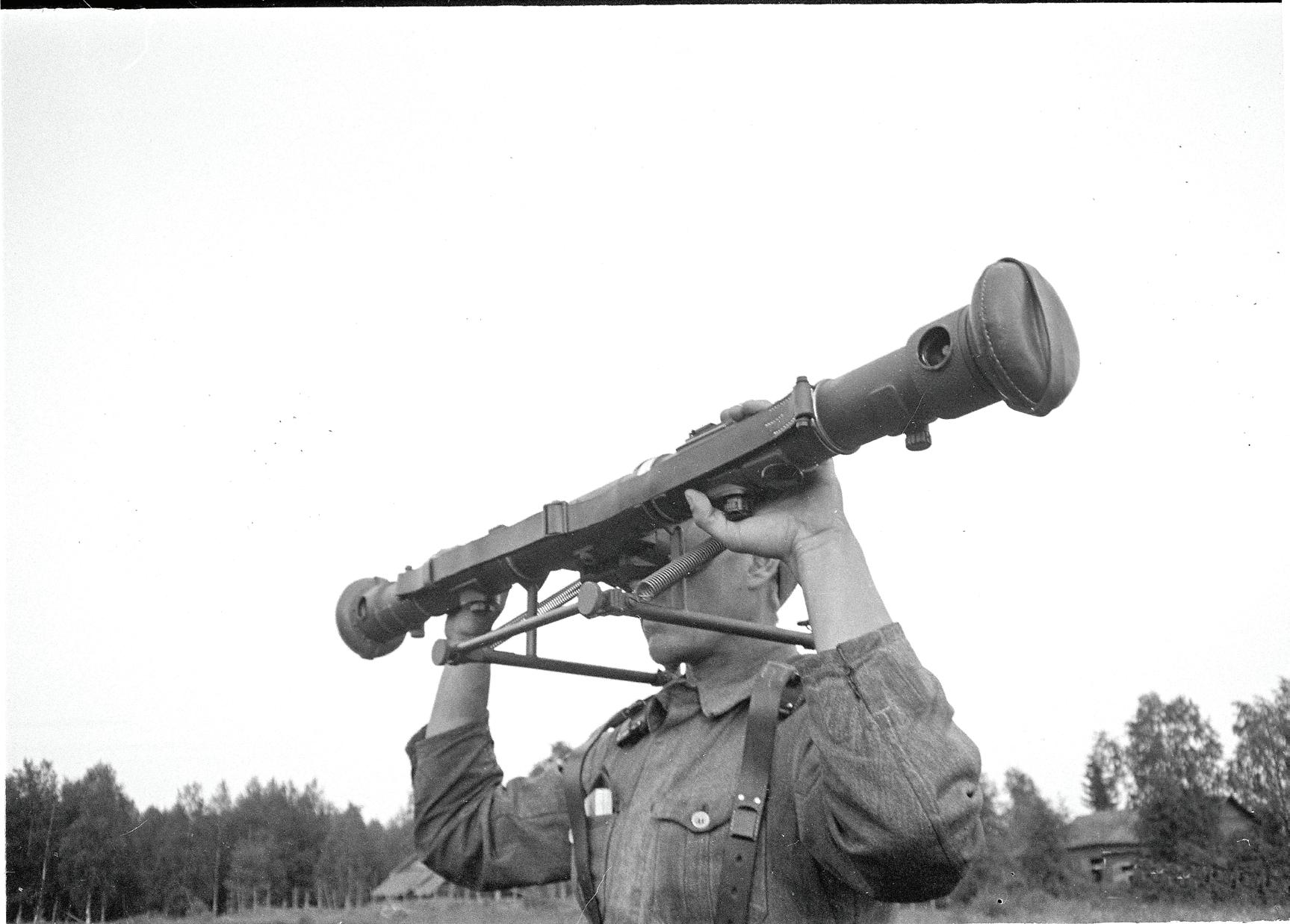









The hardy Finns were experts in moving around in difficult terrain and harsh winter conditions.





the later part of 1941.
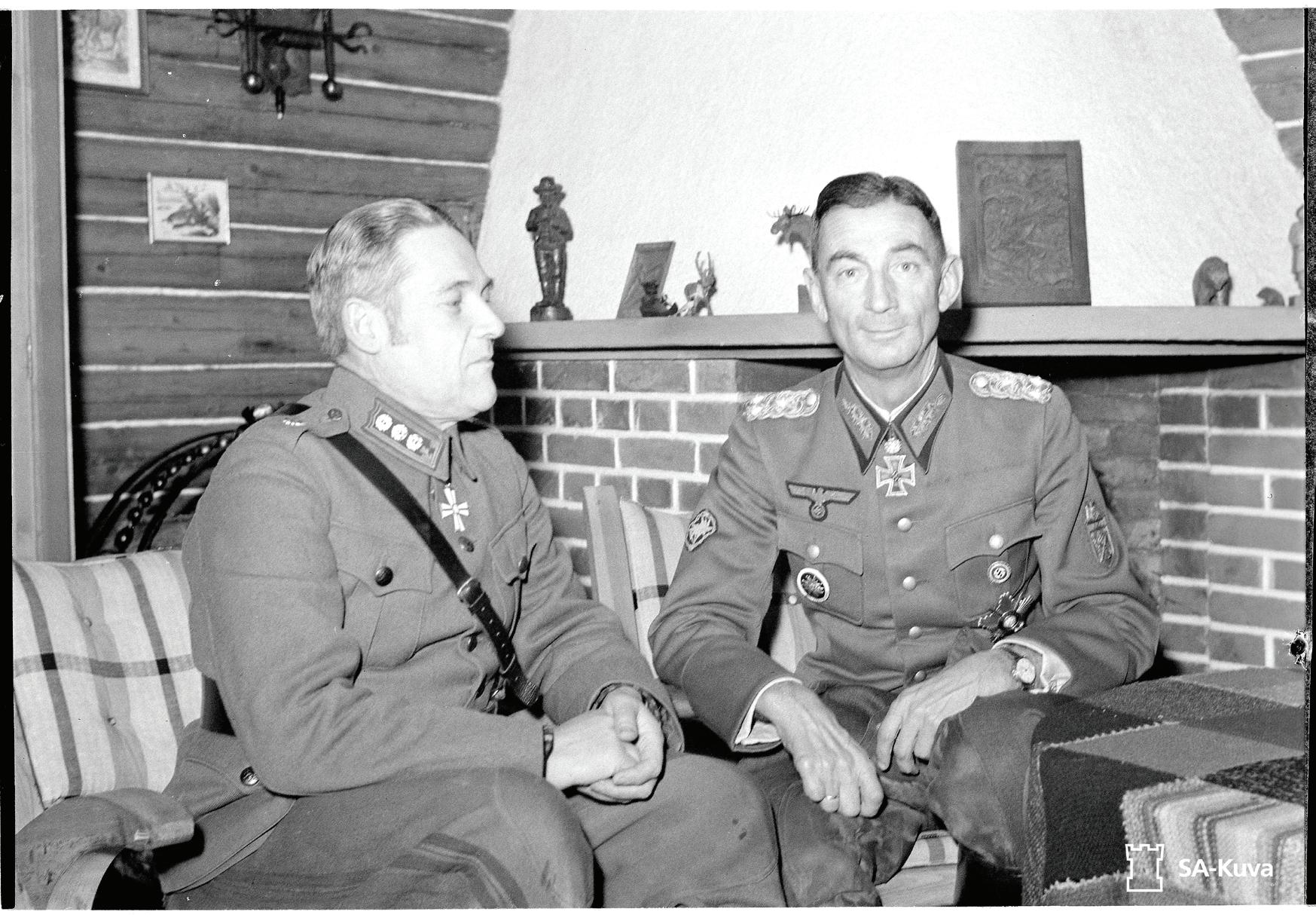
form, did not always take to heart his warnings or advice.

The unfortunate Red Army prisoners. If the human wave assault didn’t kill them, repatriation into the waiting arms of the NKVD guaranteed a bullet in the back of the head. A morale booster to the


Outnumbered, out gunned but never outclassed. The highly motivated Finnish soldier defending his homeland from invasion.

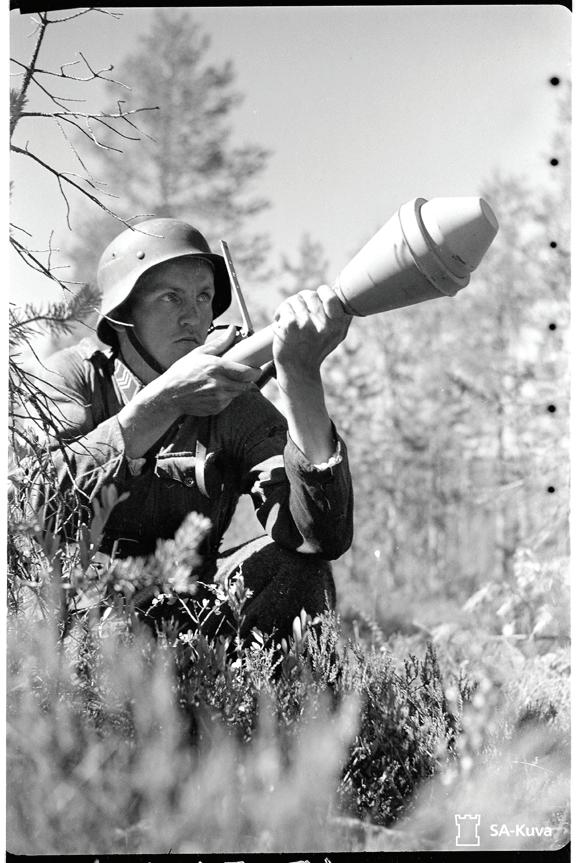


Sisu is a Finnish concept described as stoic determination, tenacity of purpose, grit, bravery, resilience, and hardiness and is held by Finns themselves to express their national character.
Image of Hitler in a dining car, on the ocassion of Mannerheim’s 75th birthday. Supposedly, a media tape recorder was accidentally left on capturing Hitler in conversation admitting to the folly of invading the Soviet Union. He was to admit he had no idea they had such an endless supply of man-

skillfully managed his relationship with Nazi Germany in maintaining war objectives important to Finland.
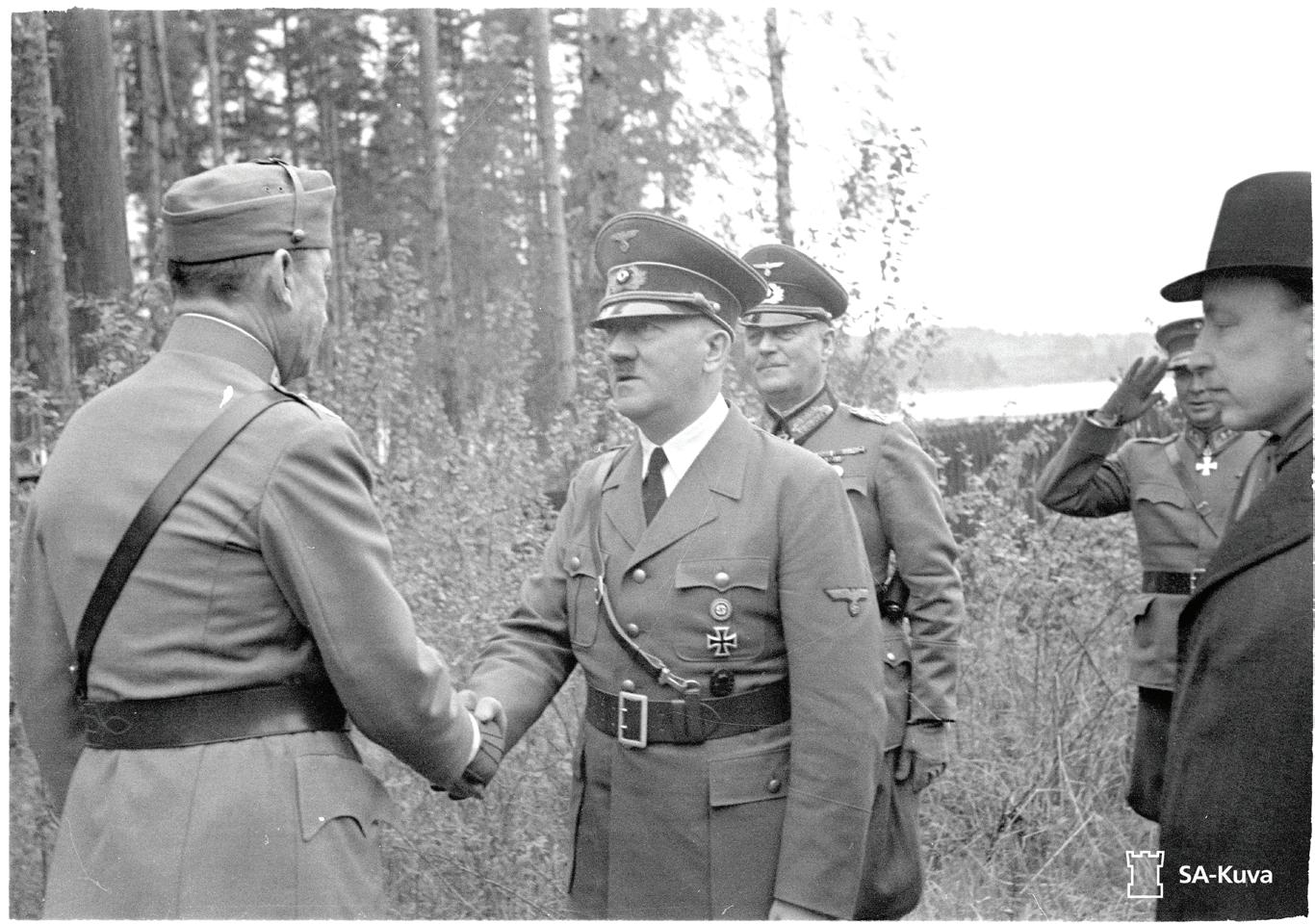

 Mannerheim and Hitler. Mannerheim
Right: Finnish Air Ace, Lieutenant Hans Wind, Knight of the Mannerheim Cross, credited with 33 kills.
Mannerheim and Hitler. Mannerheim
Right: Finnish Air Ace, Lieutenant Hans Wind, Knight of the Mannerheim Cross, credited with 33 kills.
/ Light Snow
Mud / Light Snow
November / December
March / April 1942 Light Snow / Light
Treat Lt. Snow as Mud
Light Snow / Snow
/ Light Snow
(maximum of 1 Stuka per attack) Mud

Light Mud / Light Snow 3/1
December and March Impulses
Treat Lt. Snow as Lt. Mud
November Impulses
All Turns:
1st Impulse

allowance for the impulse.
of all other units to determine movement
Russian Player
impulses as Mud Impulses
For 1943-1945 turns, treat all Lt. Snow
German Player
weather is Lt. Snow.
• No Blitz Attacks in the First Winter impluses only where
-1 DRM for Axis units in combat supply (First Winter)
defending units are out of combat supply (First Winter)
+1 DRM to Russian Attacks if any of the
-1 DRM when attacking in Second Winter
-2 DRM when attacking in First Winter
SS, not in combat supply suffer the following DRM:
• Axis units, other than FINN, Mountain, Luftwaffe or
• Axis units are NOT halved when NOT in combat supply
Combat Effects of Lt. Snow
March/April Lt. Snow/Lt. Mud 0
Lt. Snow/Snow -1
Mud/Lt. Snow 0 (+1 in 1941)
Lt. Mud/Lt. Snow +2 (+3 in 1941)

November/December Modifier
When playing with Optional Rule A24.0
Weather Die Roll Modifiers for Lt. Snow
player may drop paratrooper units.
Subtract 1 from the movement factor
Number in Circle:
Beginning with November 1942 turn, the Russian
Russian Paratroop Air Drops
Lakes and Rivers: Do NOT freeze over.
If playing with Optional Rule A5.0,
Swamps: Do NOT freeze over.
Supply Effects of Lt. Snow
May not be used for movement during Lt Snow.
Leningrad Ice Road
modifiers for airbases.
Sea Movement Players do receive sea movement die roll
March Turns Treat as SNOW
December Turns Treat as SNOW
Turns
Treat as NON SNOW
ver. 2
Chit
Pulled Year 1942 1943 1944
1 2 3 4
Voronezh Hexes 1721->1821->1922 Odessa
Stalingrad Minsk Lvov
Maikop Oil Kiev Brest Tula Dnepropetrovsk Konigsberg
5 Leningrad Sevastopol Ploesti Oil
6 Kalinin Riga Bucharest
7 Hex 0107 Wilno Warsaw
8 Maikop Dnepr Hexes 2525->3022 Danzig
9 Novorosiysk Kharkov Constanta
10 Krasnodar Stalino Kracow

Chit
Pulled Year 1942 1943 1944
1 2 3 4
Voronezh Hexes 1721->1821->1922 Odessa
Stalingrad Minsk Lvov Maikop Oil Kiev Brest Tula Dnepropetrovsk Konigsberg
5 Leningrad Sevastopol Ploesti Oil
6 Kalinin Riga Bucharest
7 Hex 0107 Wilno Warsaw
8 Maikop Dnepr Hexes 2525->3022 Danzig
9 Novorosiysk Kharkov Constanta 10 Krasnodar Stalino Kracow
If players are playing only Rules 40.0 to 40.07 apply the rule as directed to add or subtract points on the Sudden Death Victory City point track. If players opt to use rule 40.08 then ignore Rules 40.0 to 40.07. Apply as follows in this example:
• It is the start of the Jan/Feb 1942 Turn

The German player draws CHIT #2 (Stalingrad) and the Russian player draws CHIT #5 (Leningrad)
Before the start of the Jan/Feb 1943 turn, the CHITS are revealed. If the German player controls Stalingrad and the Russian player does not control Leningrad, the German player wins. If the Russian player controls Leningrad and the German player does not control Stalingrad, the Russian player wins. If both players control their objectives, or if neither player controls their objectives, the game continues another year and you repeat the process for 1943 and 1944, if necessary. If play continues to 1945, use Rule 27.0.
Page 4
On page 4 of the Player’s Guide, third paragraph, the text reads:
“The +1 die roll modifier for the first turn surprise (first impulse only). There are not terrain modifiers in the first turn. Rivers are not doubled in the first turn!”
This should read as follows:
“The +1 die roll modifier for the first turn surprise (first turn only). There are no terrain modifiers in the first turn. Units behind rivers are not doubled during the first impulse of the first turn.
In the main rule book, see Rule 24.21 for river doubling and Rule 24.22 for die roll modifiers.
There is an error in wording in regards to the example I was trying to show. During an adjustment of the example, I failed to fully update the wording.
The die roll result is a D1. The example is correct up until this sentence:
“The German play must take a step loss. ... “
On a D1 result, only the defender takes the step loss. So this is incorrect. The point I was trying to make was if the result was a BR or an EX, then the rest of the verbiage is correct.
Rule 10.61 does a good job of explaining step losses and if armor is used in the attack.
In the box on the lower right had corner, the Combat Effects of Lt. Snow box, a word was left out of the first sentence in the box.
It should read:
Axis units are NOT halved when NOT in combat supply
A reprint of the corrected chart is on Page 33.
Page 36 Oil Wells 21.05 to read:
Oil Wells unable to trace a General Supply line to an unlimited supply source have their cumulative oil points reduced to 1/3, fractions rounded up.
Ideally, the chart at the bottom of the page would have the city names rather than the hex number. But that was not possible due to space constraints in the guide.
I was lucky enough to have some space here and have included it. There are no corrections or errata, simply copy page 30 in this booklet and use for reference if you decide to use this rule.
I strongly recommend you also use the following rules in conjunction with Rule 40.0:
As another variant to that rule, if both players agree, you can opt to use it instead of the Immediate Russian Victory Chart (Sudden Death).
So, instead of the German player having to control a minimum number of Victory Cities, substitute Rule 40.0. If both players control their CHIT requirement, the game continue through to the next year. It continues as well if neither player controls their CHIT requirement. If one player does control the required objective and the other doesn’t, he is declared the winner.
The whole purpose of the Advanced Rules is to provide players with different variations, options and some historical flavor to spice up the game. You are free to use any combination of Advanced Rules to enhance your Russia Besieged experience.
As always, both players must agree to the use of Advanced Rules or they may not come into play.
The Rule Book that comes with the game is the Official set of standard rules for Russia Besieged. All regular tournament play is based on those rules and those rules alone. Refer to them for final clarification.
Any and all Advanced Rules may be used in tournament play but only if the Gamemaster so determines their inclusion and his word is final. Players may at any time (including in tournament play) include any Advanced Rules but only if both players agree.
Historically, both Stalin and Hitler remained in their respective capitals when it looked like the end was near. This rule reflects their steadfast conviction to victory.
62.01 Stalin may not move out of Moscow in 1941. He may move out of Moscow normally starting on Turn 5.
62.02 Hitler must return to Berlin and remain there until the end of the game at the start of Turn 23. Simply pick up the Hitler piece and place it in Berlin on that turn. If Berlin is not available, place in any other German major city. If no other German major city is available, the Russian Player wins the game.
Since we introduced entrenchment counters, there has been a lot of debate on how they should work. This is another variation. Pick one or the other but not both rules, should you choose to use Fortification Counters.
The Fortification Counter rules in A 32.0 provide for doubled defense strength and a – 1 DRM, but the defending units lose their ZOC. This makes them very powerful in defending the approaches to Moscow and the Crimean Peninsula, but the loss of the ZOC makes them impractical most other places. This Variant follows the same A 32.0 rules, but has different effects.
Fortification Counters provide a – 1 DRM but do not double the defending unit or eliminate the ZOC. Units in Fortification and adjacent to enemy units are not required to attack.
However, if a unit does attack, all units exerting a ZOC on the attacking unit that are not across a river hexside must also be attacked.
Fortification Counters cannot be built in major cities, with the exception of Leningrad, Stalingrad and Sevastopol. Those major cities lose their ZOC when that is done. (If both players agree, a Fortification counter may also be placed on Brest At Start).
63.01 Units under a Fortification Counter are NOT doubled on Defense.
63.02 Units under a Fortification Counter HAVE a normal ZOC.
63.03 Units under a Fortification Counter have a -1 DRM when attacked.
63.04 Fortifications may only be made on clear terrain.
63.05 Fortifications may be built in minor cities in clear terrain.
63.06 The Fortification -1 DRM is a cumulative modifier. If all units attacking a Fortification are across a river hex spine, then the total DRM is -2.

63.07 Fortifications may not be attacked on the Blitzkrieg Table, only on the Combat Results Table.
63.08 Refer to Rule A 32.0 for all other content.
Wargames are challenged to accurately reflect some battlefield situations. These may include combat results that call for retreat, but where the player opts to retreat forward, actually capturing new territory. A similar situation occurs when player may advance units that are completely surrounded and occupy new territory because they are not restricted by enemy Zones of Control. This rule is intended to restrict defeated or isolated units from ahistorically advancing to capture new territory rather than retreating towards their own lines or attempting to breakthrough to reestablish lines of communications and supply.
64.01 Units that are surrounded and cannot trace general or combat supply may not move such that the move is designed to capture new ground. Movement must have an end purpose to establish a renewed link to friendly supply.
64.02 Combat may not occur unless it is specific to opening a line of supply. An attack may not occur if the enemy unit being attacked is in a hex such that the attacking friendly units had to move further away from their friendly board edge in order to make the attack. The only exception is if a successful attack or combination of attacks would open a line of supply.
64.03 Under any circumstances, units that are surrounded and out of supply may not:
• cross a border into an enemy country
• if in enemy territory, may not capture a Major City unless it would open a line of supply
• leave an enemy ZOC to attack units where there is no impact on re-establishing a line of supply
• attack non-adjacent enemy units that are not blocking their line of supply
64.04 If the friendly player can bring into play immediately, one attack at 1:1 odds or greater to clear a path, then the surrounded units may make an attack to clear a path. The friendly player must execute the 1:1 or greater attack.
Both the German player and Russian player forces may utilize Combat Rail Capability. The concept being that units may rail and possibly attack in the same impulse.
65.01 All standard 7.0 Rail Movement rules apply with the exception of 7.04.
65.02 All ground forces may move 1/2 of their movement point allowance for the impulse to:
1) move to a friendly controlled rail hex - once on the rail hex, they may conduct rail movement normally but may not move off the rail hex they end their movement on or
2) move off of a friendly controlled rail hex after the unit has completed rail movement and move 1/2 their movement point allowance
65.03 All movement point allowance fractions, when dividing by 2 are rounded up.
65.04 Units that move and then rail may begin the turn in an enemy ZOC as long as they can legally exit the hex.
65.05 Units that rail and then move 1/2 their movement allowance may enter an enemy ZOC and may conduct combat resolved on the CRT. They may not participate in Blitzkrieg Combat using this rule.
65.06 Units with “0” movement point allowances for the impulse may not use this capability.










65.07 Unlike regular rail, which is unlimited in distance, combat railed units may only travel 20 rail hexes maximum and either disembark and move or end their movement.
Example #1
Weather: LT MUD
Players may break down Panzer Corps/Army counters at their discretion during the course of play. If this rule is utilized, players must take extra care to have the proper number of counters on the board during play.







66.01 Players may freely breakdown Panzer Corps and Army counters at their discretion. Only German Armor and Russian Guards Armor may break down this way.
66.02 Only a Full Strength Armor unit may break down.
66.03 Breakdown occurs duing the movement phase. The friendly player declares he will breakdown the unit of his chosing and replaces the counter on the board with the breakdown counters as follows:
NOTE:
Flip to Reduced Side Add this counter
Full Strength Parent Unit +
Flip to Reduced Side Add this counter
Example #2
Weather: CLEAR
Any two Armor counters may combine to rebuild as long as the combat factors equal the face value of the parent at full strength. SS units may be rebuilt with any combination of German units.
• 41 Armor does not start on Rail hex
NOTE: Maximum hexes travelled is 20 rail hexes in total.
• 41 Armor Starts on Rail
• Movement Points for LT Mud are 5
X X Y 1 2

• Movement Points for CLEAR are 8
• 8/2=4
• Armor moves
66.03 Terrain does not prevent this breakdown. However, stacking rules apply at the end of the movement phase. Individual broken down units act like all other armor units for all intents and purposes.
66.04 Panzer Corps/Army may be refitted at any time back to a full strength counter. The following conditions apply:
• all refitting happens any time during movement
• 5/2=2.5=3
• Armor rails to hex and then moves
Z Z Z 3
3 hexes and engages Russian Infantry
Y
• if the two similar corps ID counters are stacked together, simply flip the parent unit back to full strength and remove the breakdown counter from the map


• if one of the units is eliminated, simply spend the required Armor/Oil Points to rebuild in place
66.05 Corps breakdown counters (final step counter) do not surrender in adverse combat results. Only the parent counter may be surrendered. If the parent counter is surrendered, it may not be rebuilt as per the surrender rules. All normal combat rules apply.
During all of the 1941 German player turns, the German player may Stage Airbases to any friendly controlled city (Rule 11.15) during any non-snow weather. This would include Mud and Light Snow.
Admirals and Richthofen function in exactly the same manner as Field Marshals in that they may impart a die roll modifier to influense certain related die rolls. (All FM rules apply to Richthofen except you may still use a FM in addition to Richthofen for a +1 or +2 DRM)


67.01 At the start of the game, the German player receives the Richthofen counter and rolls the d10 die for the Admirals. He receives one Admiral on an even die roll and two Admirals on an odd die roll. The Richthofen counter can be used twice in 1942 and each Admiral counter may be used once in the game.
67.02 Admirals are used in the same manner as Field Marshals. Before any enemy action, the German player announces he will deploy an Admiral to impact the die roll. The Richthofen counter may only be used in 1942.


67.03 Admirals may only be used to impact Naval die rolls related to Naval actions by either player.
67.04 Admiral counters are available from Turn 1 through to Turn 23. On Turn 24, all unused Admiral counters are permanently removed from play.
67.05 Place Admiral counter(s) in the Available Field Marshal Box until used. Once used an Admiral is used, the counter is premanently removed from the map.
67.06 Richthofen may be used in conjunction with any attack that utilizes a Bomber in addition to or separate from the use of a Field Marshal.
Ports Controlled
Russian
• Leningrad DRM 0
German
• Stettin DRM -1
• Danzig DRM -1
Konigsberg DRM -1
• Riga DRM -1
• Tallinn DRM -1
• Helsinki DRM -2
German Airbase -1
Total DRM -9
When the German player is ready to roll the dice he can declare he intends to use an Admiral. He places the Admiral on the board and rolls adding a -1 to the die roll. In this example, the total DRM would be -10.
If the Russian was attempting an invasion to Helsinki, the DRM would be +2 and +1 for the Admiral.
68.01 For this Advanced Rule, a friendly City may be one captured during movement in the current impulse. The German player could move friendly units, for example, through Kiev and then immediately Stage an Airbase from Kracow to Kiev. In the second impulse, the Bomber would be available to fly a normal combat mission.
In keeping with the spirit of how circumstances on a game board may not mimic the realities of the battlefield, this rule is a minor adjustment to Rule 13.0 of the main Rules Book.
69.01 [This rule follows Rule 13.45. Consider it to be Rule 13.46, in other words.]
Any unit that has an OoS Marker place on it surrenders if it cannot open a line of supply at the end of the friendly player turn as per Rule 13.43. If that marker is on top of a Major City hex and that City hex is reinforced in some way while the OoS marker is on the units in the City hex, all units suffer the same results if a General Supply Line is not open at the end of the turn that determines the units fate.
Example
There is a Russian 2-3 in Riga with a OOS-1 counter on it. The Germans continue to siege Riga. On the Russian turn, they sea transport a 4-4 into Riga but do not break the siege and restore supply. At the end of the Russian turn, both Russian units surrender.

The Transported unit does NOT start another turn of drawing supply from a Major City.
Note:
During the Siege of Sevastopol, the Russian Navy continued to bring fresh troops into the surrounded City up until the City surrendered.
The units freshly transported suffered the exact same fate as those who had fought bravely to defend the City from the beginning of the siege.
At the last minute, the Soviet Navy evacuated as many Specialists and High Ranking officers as they could and left the rest to their fate in the hands the victorious German Army.
This Rail Capacity modification allows a little more flexibility for the German player. Refer to the Player Aid Card that originally came with the game and update it to this variant if both players agree to it’s use.
Sea Move Fails
Sea
Sea Move Fails - unit eliminated
Sea Movement Aborted - Return to Port - 1 Step Loss
Sea Movement Aborted - Return to Port
Sea Movement Successful - unit takes 1 Step Loss
Sea Movement Successful - unit takes 1 Step Loss
Sea Movement Successful Sea Movement Successful
+ 2 i f controls his own Major Naval Base at the start of the impulse (See Rule 8.2) +
f or each other port controlled at the start of the impulse +
i f destination hex is within 9 hexes of a friendly airbase -2 if destination hex is within 4 hexes of an enemy Major Naval Base (Rule 8.2) -1 for each other enemy port within 4 hexes of the destination hex
if destination hex is within 9 hexes of an enemy airbase



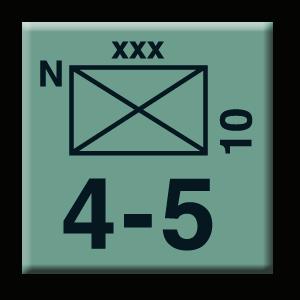
Rail capacity for the turn remains the same at 6 counters. What has changed is the distribution of those 6 counters. A maximum of 5 units may be railed in the first impulse in Non Snow turns, a decrease of 1, but an increase in the number that can rail in the 2nd impulse.
Overall effect on play is minimal. The benefit to the German player is a little more flexibility on when he can rail units.
The Sea Movement Table does not have the same flow as the rest of the Tables in Russia Besieged but a small oversight. All other Tables work such that when you roll the die, a low roll is not as desirable as a high roll. There is no errata or anything wrong with the Table. Just the ergonomics of how it works. We have adjusted the Table here, so it has the same flow as all the other tables. Use it if you like, there is nothing to update or learn in the way of new rules or changes. Just make sure both players are in agrement to the change before you use it.
See the table at the top of the next page. You will see that everything is now reversed ....
The old top 4 results were:
Sea Movement Successful
Now, it is the BOTTOM 4 results that show success:
Sea Movement Successful
The table has simply been inverted along with the DRMs.
This rule will allow players to enhance the way they recieve Replacements duing play. Instead of just bringing in full units from the Replacement Pool, or rebuilding depleted units on the map, players will now be able to upgrade full strength units on the map with replacement points.
72.01 During the movement phase, players may now take Replacement Points and upgrade full strength friendly units on the map if a higher strength unit of a similar type is in the Replacement Pool by spending the difference in replacement points to upgrade to a higher combat factor counter.
73.02 In order to do the upgrade, the counter upgrading to must be in the Replacement Pool and the unit must be of the same type. Example: Infantry for Infantry.
72.03 When using this Advanced Optional Rule, please adhere to all rules as they apply in Rule 19.0 of the main Rules Book.
EXAMPLE
This unit is on the game map
This unit is in the Dead Pool!
Since both units are INFANTRY, spend 2 Replacement points and change the 4-5 to a 6-5 on the map!
Before After 2431 2431
Spend 2 Replacement Points
This Guards Cavalry Upgrade rule allows players to upgrade Guards Cavalry units to a slightly more powerful version used later in the war.
74.01 Rule 24.5 allows for all German units to cross rivers and not pay the +1 additional MP cost during May/Jun 1941 Turn. When using this rule, extend the time period through the 1st Impulse of the Jul/Aug 1941 turn. At the start of the 2nd Impulse of the Jul/ Aug1941 Turn,apply the regular +1 MP cost to all German units crossing a river hex spine.



74.02 Players may use this rule in conjunction with any other Shock of War rule that may pertain to the cost of river crossings.
73.01 In the Mar/Apr 1944 Russian turn (Turn18), the Russian player may upgrade a 4-8 Guards Cavalry Corps to a 5-8 by expending 1 Replacement Point in the same manner as rebuilding a reduced strength unit.
When using this Variant, add a special Guards Cavalry Field Marshal, Belov, to the available Russian Field Marshal box in Nov/Dec 1941 (Turn 4).
This rule allows the players to convert combat factors to RPs that can reinforce existing units or create corpsand army-sized units in subsequent replacement phases.
75.01 Any unit in General Supply may donate some of its combat factors to the appropriate RP pool by taking one or more voluntary step losses and adding those combat factors to the Replacement Point totals. These points are donated in one impulse and may be used in the next following impulse to rebuild another unit.
73.02 In Nov/Dec 1941 turn (Turn 4), add Belov to the available Russian Field Marshal box. He is available for use at the moment of entry.
73.03 Belov may only be used when at least one Cavalry corps is used in combat. Belov may only be used once and then he is permanently removed from the game.

At the start of Operation Barbarossa, the Germans employed a number of Bridge laying vehicles used to quickly get troops across rivers and any anti-tank ditches they may encounter at the start of the invasion. Speed was the key!
A unit in General Supply that is not in an enemy ZOC may be “eliminated” by donating all its remaining steps, removed from the board and placed in the friendly replacement pool box to be rebuilt at the friendly player’s discreation.
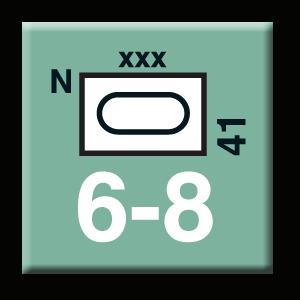

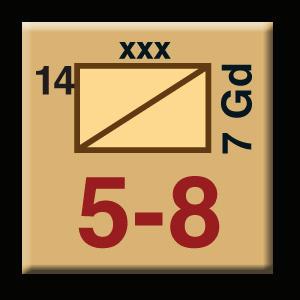





Exception: A Shock Army may not disband by donating all its combat factors.
75.02 Units donate the type of RP they use when receiving replacements.
75.03 A unit may donate combat factors before or after its movement for the turn but not during or after combat.
75.04 To donate RPs, invert or remove the unit depending on how many steps it will donate, calculate the number of combat factors that correspond to the number of donated steps, adjust or remove the unit as appropriate, and move the “replacement point counter” as is appropriate to reflect the donation of factors made.
The use of these vehicles and the element of surprise was initially met with great success, allowing the German spearheads to make great inroads into the interior of the Soviet Union.
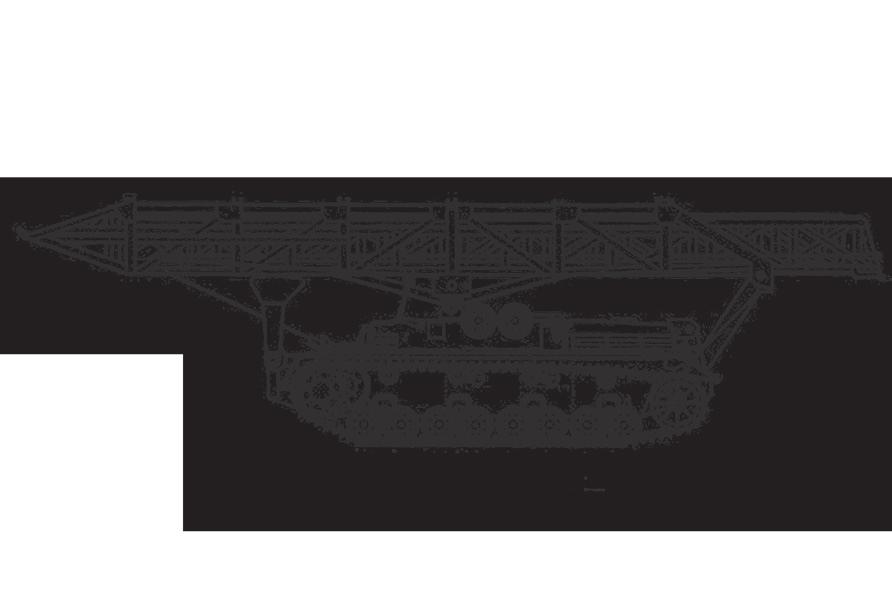
The Designer Setup was created to give you a solid setup option if you are new to the game or simply looking for something new to try. There are a plethora of options for setups in Russia
Besieged and no one setup is foolproof. This particular setup is designed to deny the German Minsk in first turn and to greatly limit the penetration of armor. Try it, feel free to modify it and adapt it to your own stratgy. I always feel if I can walk away with 5 or more frontier troops to start the Russian turn, I am ahead of the curve.
Leningrad MD
7th Inf Hex 0312
23rd Inf Hex 0414
Baltic MD
12th Mech Hex 0725
8th Inf Hex 0825
3rd Mech Hex 1024
11th Inf Hex 1024
Western MD
11th Mech Hex 1127
3rd Inf Hex 1127
6rd Mech Hex 1226
14th Mech Hex 1326
4th Inf Hex 1328
6th Cav Hex 1328
10th Inf Hex 1628
Moscow
20th Inf Hex 1812
11th Mech Hex 1913
Minsk
13th Inf Hex 1622 (or Hex 1623)
20th Mech Hex 1524
Kiev
21st Inf Hex 2423
24th Mech Hex 2424
Odessa MD
9th Inf Hex 2731
2nd Mech Hex 2932
6th Cav Hex 3232
Reserve Mech
15th Res Mech Hex 2229
Kiev MD
5th Inf Hex 1829
12th Inf Hex 1932
4th Mech Hex 2029
5th Cav Hex 2029
NOTE:
26th Inf Hex 2131
22nd Mech Hex 2131
8th Mech Hex 2430
6th Inf Hex 2431
The units shown here can either set up freely within the speci ed Military District or may be adjusted by one hex from the speci ed city. The units starting in a named city can also be adjusted by one hex.



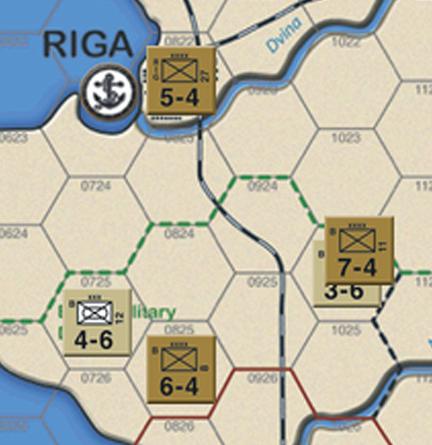




Where do I begin? Rob Beyma is mentioned often in my commentary of key people who contributed greatly to the development of the game. Without his help, Russia Besieged would not be the game it is. Lembit Tohver, of course, has been by my side through thick and thin since the early 2000’s and was a very strong early contributor to the game.
I also want to thank Paul Popejoy and Tim McNeil for their contributions. Without their help, these Guides and scenarios would not have been the same. I really cannot adequately express the magnitude of appreciation I have for their help and for the help of everyone, over the years, who have contributed to this ongoing project.
I would also be remiss if I did not give a shout out to Bill Thomas and Ken Dingley of Compass Games. What a pleasure to work with you on this project. Thank you for your support and belief in the product.
Collectively, I am in your debt.
Where does Russia Besieged go from here? Other than minor tweaks and maybe some new scenarios, I don’t think there will be any more rules or player’s guides. I am considering a deluxe map with a heavier stock board at some future date.
I may put out a Rules Anthology of some sort, along with a complete and comprehensive index and maybe even an electronic version of the rules on a disc, in a database format for easy searches and reference. Watch the forums for any information that may be forthcoming on these projects.
Again, thank you, the customer for your belief in this product. I hope you get hundreds of hours of enjoyment from playing the game.
Over the course of almost two decades of play, I have some personal thoughts on what rules should be standard play. As of this printing, it is too soon to say whether or not these rules are solid in terms of play balance, but they are rules I really like. They impart more fluidity to the game and also allow for the German player to be able to advance more rapidly, early in the game, into the Caucasus region without worry of being slaughtered on other areas of the map. They also allow for a more spirited effort on Moscow itself in 1941. In my opinion, this rules option allows for a more historical course of play, should the German player choose to explore it. I would make these set of rules the standard for regular play.
The Designer’s Game adds the following Advanced Rules to the Standard Rule Book. Do not remove any of the rules listed below, the game must be played with this standard rule set. [You may add other Advanced Rules, but only if both players agree].
A 4.0 Historical Weather
A 6.0 Siberian Troops
A 18.0 Rail Movement
A 27.0 Airbase Deployment in Clear Terrain
A 30.0 Bomber Extended Range Rule
A 31.0 Hans Ulrich Rudel
A 43.0 Bomber Advanced Turn Sequence
A 48.0 Fortification Cities
A 50.0 Seelowe Heights
A 57.0 German Security Forces

A 58.0 Strategic Movement
A 60.0 Shock of War Adjustment
A 61.0 Oil Wells - Historical
A 62.0 The Last Stand
A 65.0 Combat Rail Capability
Art Lupinacci
F 1.0 Expansion Map Exclusive Rules (this is optional but highly recommended)
Also offered on Page 45 is the Designer’s Setup for the Russian Player. Created to offer those who are new to the game a solid initial setup that can save you some units and limit German penetration. Alter and experiment with the setup as you become more familiar with the game.



Example of City Capture Rule A XX.X Germans did NOT enter Voronezh. However, it is in a German ZOC and all rail lines leading into the City are German controlled and lead back to the West edge of the board. Voronezh converts to German Control and Railhead markers go to 2813, 3113 and 2815.

Note: 55th Infantry can move to hex 3117 and rail to 3714 (Railhead) but must stop there. It had to move to a rail line first.



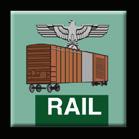















This is an Official update to Rule 4.1 in the main Rules Book. Add the following to Rule 4.1 on how a player gains control of a City:
An enemy city that meets all of these criteria also converts to friendly control at the end of the impulse:
• the City is vacant
• the City is in the ZOC of a friendly unit and no enemy unit ZOC is present
• the City cannot trace General Supply
Russia Besieged is rich in Rules, both in the Standard Rules book and in the Advanced Rules published over the course of time. Player’s are free to mix and match rules to suit their needs for historical feel, tournament or standard play as long as both players agree. In the event that players may not come to an agreement in non tournament play, the standard Rules Book rules apply.
In Tournament play, the Gamemaster, at his discretion, may select rules as he sees fit to balance the game for Tournament play. His decisions are final.

Russian Supply life line. Rail line traces to the West Edge of the map.
Russian units may NOT cross the border into Poland (German Territory)
If the border was two hexes further East, the Russian units could move to attempt an attack on the German 4-5 Infantry unit at 2:1 odds because if the unit is elminated, a path would be opened along the rail line marked in brown to a Russian unlimited supply source.
IF the Russian player declares he will attempt to save the surrounded units, the surrounded units are not elminated. They may attack the 4-5 German Infantry.
The Russian Player must be able to make, at the very least, a 1:1 attack on the German unit at the hex marked “X”. The attack must happen either in the first or second impulse, regardless whether or not the surrounded units survive their attack on the adjacent unit. Failure to make the attack negates any attack by the surrounded unit and results in their surrender.
IF the Russian player choses to do nothing, the Russian stack is eliminated. No attack is made. Place the units in the Russian Replacement Pool box and the units may be rebuilt.
NOTE:
The 3-6 Mec and the 7-4 Infantry would only be allowed to attack the adjacent units surrounding them IF the Russian declares he will attempt to save these surrounded units and bring to bear the necessary forces to make 1:1 or greater releiving attacks.

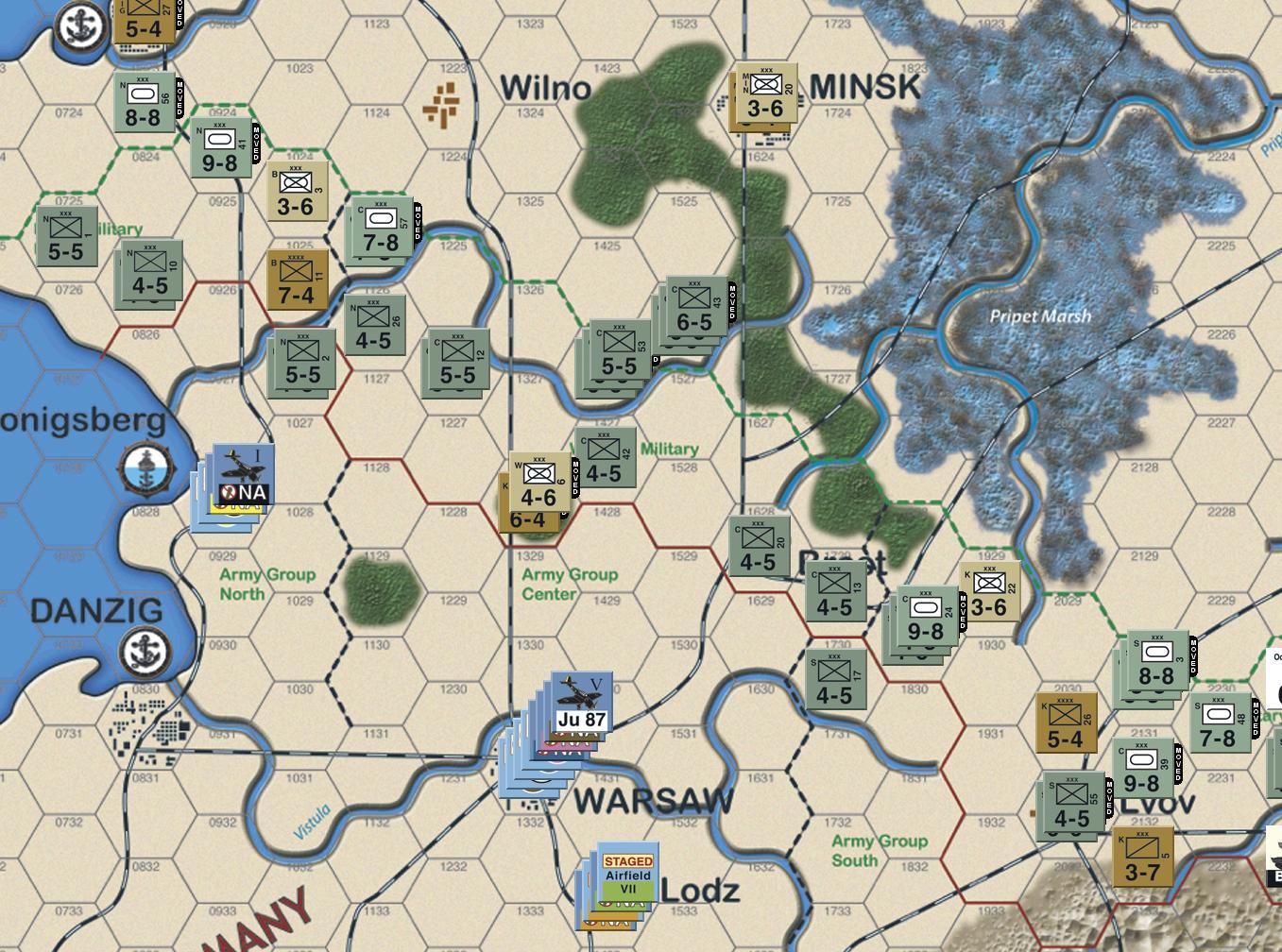
In the second example above, the Russian unit may move through Russian territory and attack the German 4-5 Infantry unit at the hex marked “X”. A successful attack against the 4-5 would result in a supply line being opened so this would be a legal move and attack.
In situation where players may not be able to agree on the legality of an attack, use the following flow chart to determine whether or not an attack can be made:
Can an attack be made at 1:1 odds or greater to clear a supply path?
Proceed with the attack as long as units may be brought to bear such that the Surrounded Units may make a 1:1 attack and relieving forces may also be brought to bear to execute attacks that could result in the opening of a Supply path to the friendly edge of the board.
• Surrounded Units Do Not Attack
• Surrounded Units are ELIMINATED
• Units may move legally to facilitate this attack either in the 1st and/or 2nd impulse in combination with other friendly units
